|
in 1927 and operated the Birney Cars and Electric Trolley buses from 1928 to 1969 |
||
|
|
||
|
Canadian Electric Locomotives
Please note that we are trying
to show only old diesels that were produced prior to 1990
|
in 1927 and operated the Birney Cars and Electric Trolley buses from 1928 to 1969 |
||
|
|
||
|
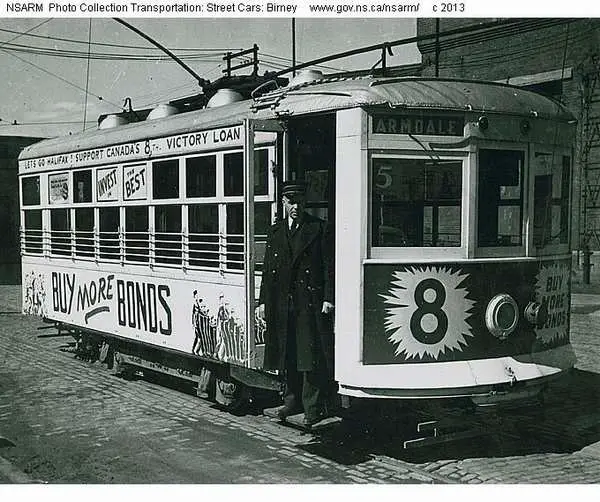 |
The Birney Safety Car was a type of streetcar that was manufactured
from 1915 until 1930. More than 6,000 of
the original, single-truck version were built It was a small and light and was intended as a economical means of providing urban service at a lower cost than conventional streetcars. Production of Birney cars lasted from 1915 until 1930. These small light weight cars worked well in Halifax because of their light weight and twin motors that that made them ideal on the steep hills. Halifax originally purchased 24 Birney Cars from the American Car Co. in 1923. In 1927 another 8 were purchased from Toronto. WW II put a real strain on the resources of the system. Prior to WW II they carried 9 millions passages a year but during the war years this increased to 31 million. Halifax continued to purchase used Birney Cars until it had a fleet consisting of 86 Birney cars. This was possible many other cities were selling of their Birney fleets. ( Note the total number of tram cars that were owned by NSLP varies depending on which source you refer to but it is safe to say that the fleet numbered over 80) This picture was taken in 1945 |
| Image courtesy of Nova Scotia Archives and Records Management, Halifax, N.S. | |
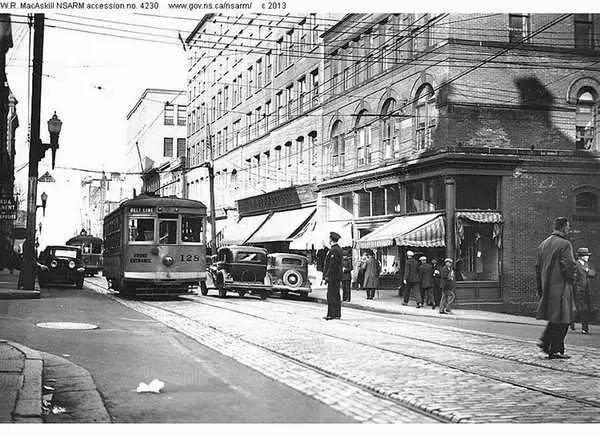 |
Birney 128 on Route 1 Belt Line travels along
Barrington Street near Sackville St. |
| Image courtesy of Nova Scotia Archives and Records Management, Halifax, N.S. | |
|
|
A decorated Birney Streetcar marked the end of
Tram-Car Service in the downtown Halifax, 26 March 1949. Service in some of the outlying areas continued until about 1951. |
| Image courtesy of Nova Scotia Archives and Records Management, Halifax, N.S. | |
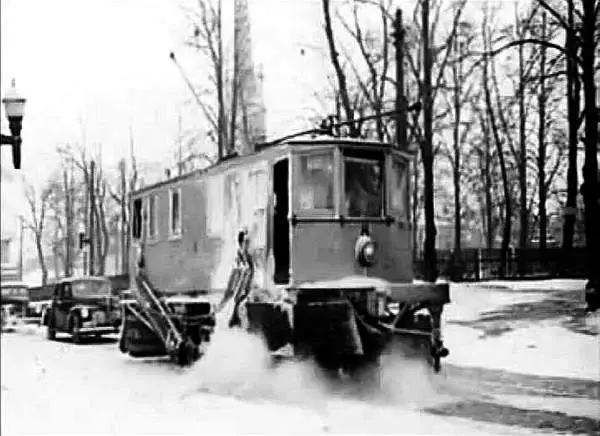 |
A Birney Streetcar converted to snow plowing and
track maintenance |
| Image courtesy of Nova Scotia Archives and Records Management, Halifax, N.S. | |
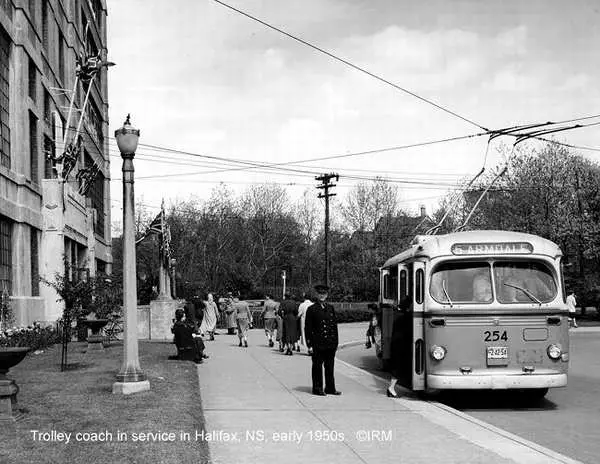 |
Trolley bus # 254 on Route 5, Armdale at Simpson's department store |
| Image courtesy of Nova Scotia Archives and Records Management, Halifax, N.S. | |
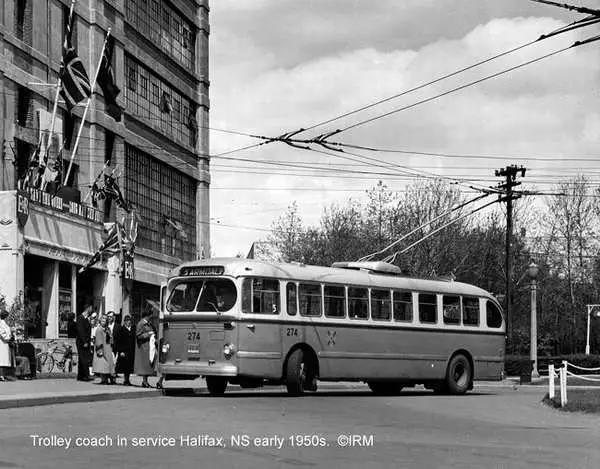 |
Trolley bus # 274 on Route 5, Armdale at Simpson's department store |
| Image courtesy of Nova Scotia Archives and Records Management, Halifax, N.S. | |
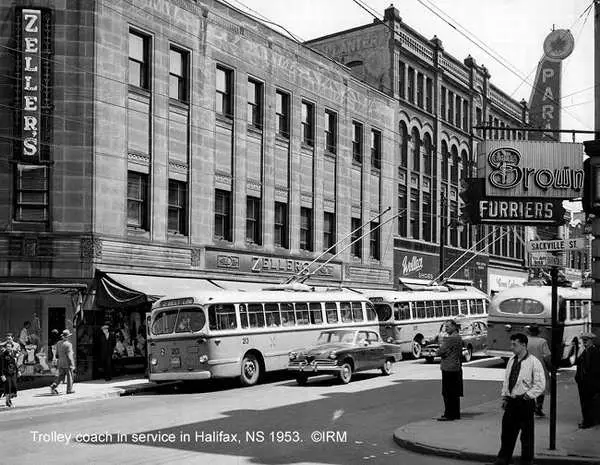 |
Trolley Buse #23, route 2 The belt Line stopped at
Zeller's on Barrington Street, 1953. These trolly busses were always blamed for holding up the automobile traffic. The car driver, myself included never gave much thought to how many cars they took off the road. |
| Image courtesy of Nova Scotia Archives and Records Management, Halifax, N.S. | |
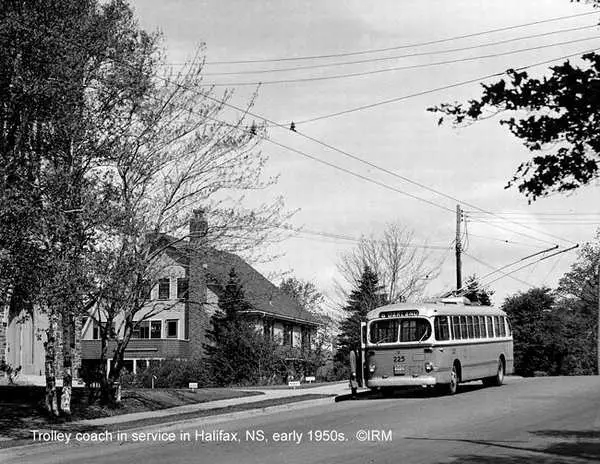 |
Trolly Buses in service in the 1950's - 1960's
Route 6, Oakland Road |
| Image courtesy of Nova Scotia Archives and Records Management, Halifax, N.S. |
 |
|
Trolley Bus Pictures |
|
|
| The Grand River Railway (GR) and Lake Erie & Northern Railway
(LE&N) were interurban electric railways operating in the province
of Ontario, Canada The GR ran northward from Galt to Preston, Kitchener,
Waterloo and Hespeler, total trackage 17 miles, and the LE&N southward
from Galt through Paris, Brantford, Waterford to Port Dover, on Lake Erie,
51 miles. Serving the highly industrialized area of Central Ontario north
and south of Preston (now part of Cambridge), the GR and the LE&N,
together formed the Canadian Pacific Electric Lines with headquarters in
Preston, Ontario, Canada. Legally they were two separate railways but operated
under common management with individual identities. Following the conversion
of the Grand River Railway to 1500-volt DC operation, equipment of both
lines was inter-mixed and running crews also worked both lines. Both lines
had frequent passenger service, and freight service, which connected with
the CP, CN, MC and TH&B railroads. The area between Brantford and Port
Dover, on the LE&N, is a well-populated agricultural area ideal for
growing tobacco, fruits and vegetables. The railway provided a way for
these products to be transported to market. The beach at Port Dover generated
much passenger traffic in the summer months. Ivey's Greenhouse, and the
fact that Port Dover was a fishing port, helped generate express revenue
for the line. This traffic would be carried to the Canadian Pacific Railway
at Galt where it would be placed on one of the mainline passenger trains
for further delivery to its destination. The improvement of roads and auto
and truck traffic cut passenger business out in 1955 and electric motor
freight in 1961. LE&N track was pulled up in the 1980's. A short section
of the GR between Waterloo (CN) and Kitchener (CP) lasted until 1993.
Brief timeline of the Grand River Railway and the Lake Erie &
Northern Railway
|
 |
|
|
| All Pictures and text provided by Berry Kelly.
His Grandfather, Frank Lediett was Station Master at the Paris Station and he spent many happy hours hanging around there when he was a kid. |
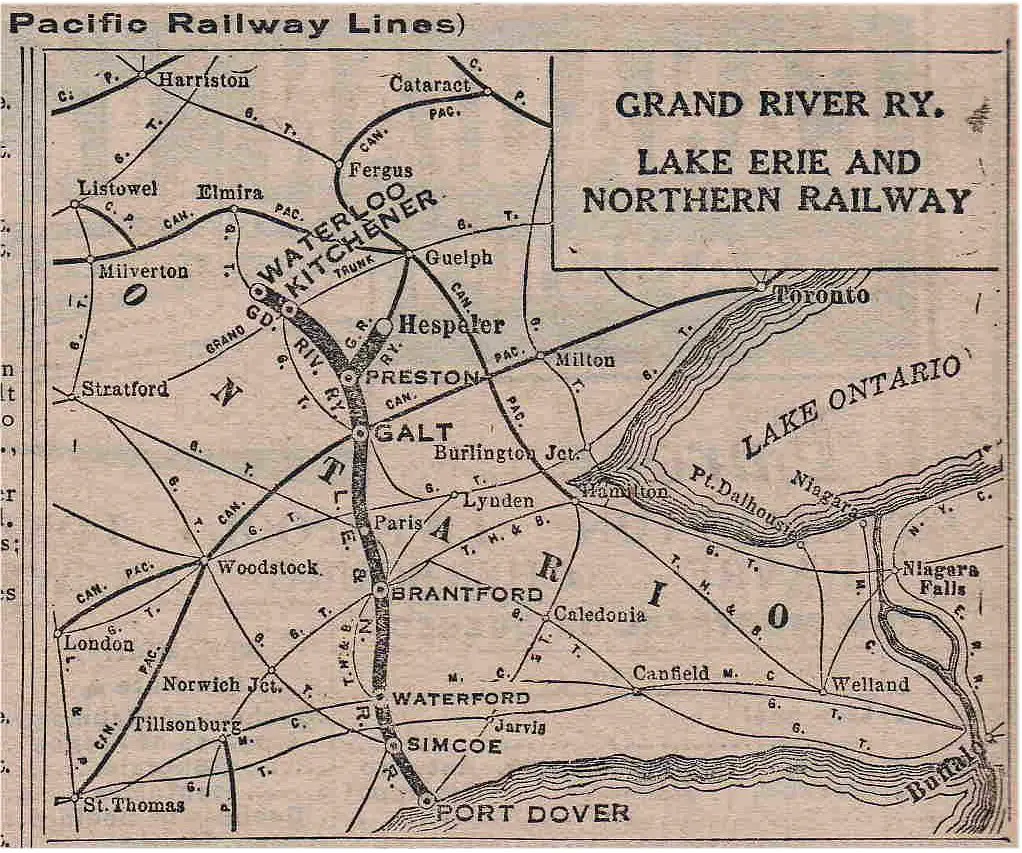 |
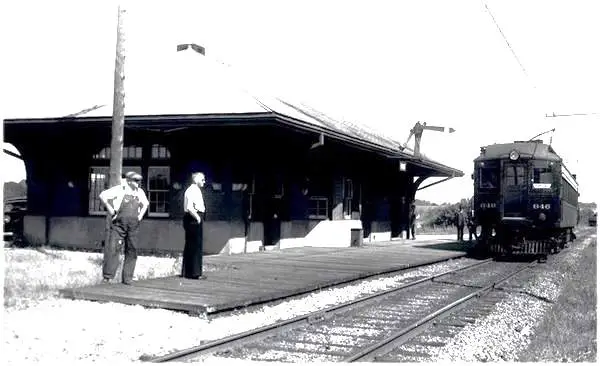 |
Car 816 at Paris late 1930's |
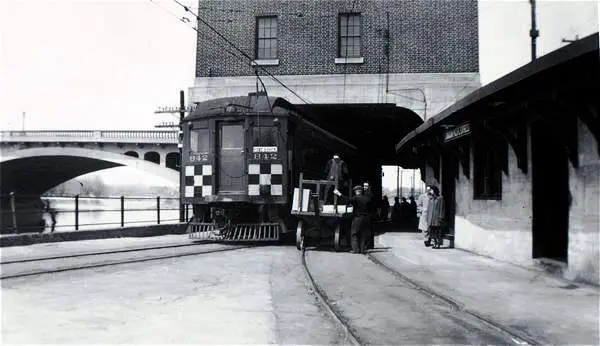 |
Car 842 at Brantford Station mid 1940's |
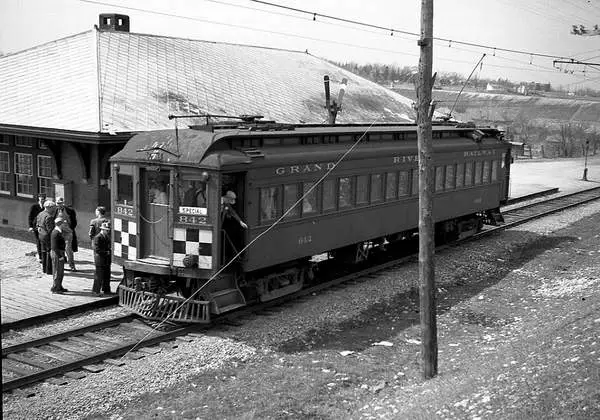 |
Car 842 at Paris late 40's |
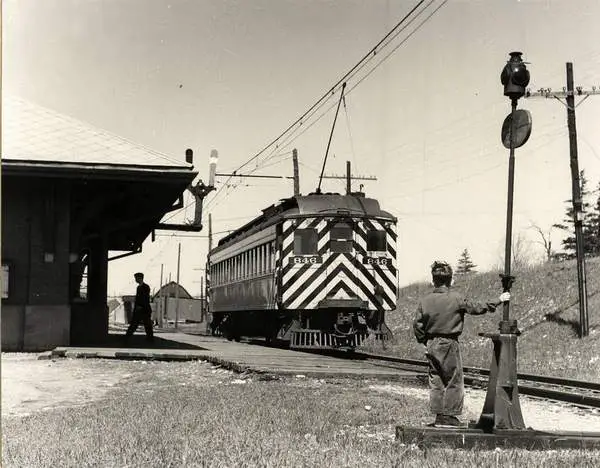 |
Car 846 at Paris early 1950's |
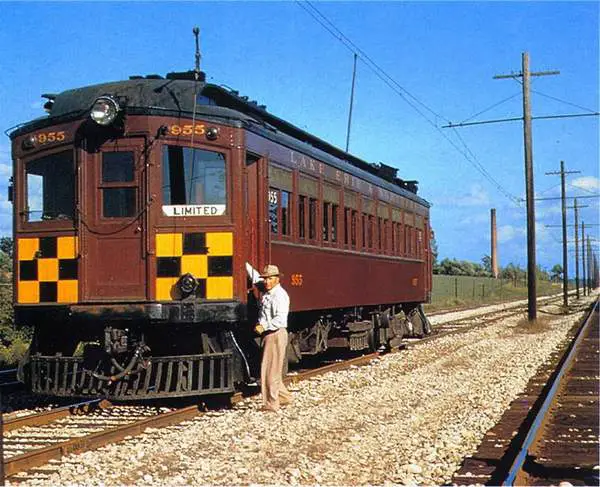 |
Car 955 Lake Erie & Northern Railway (LEN) |
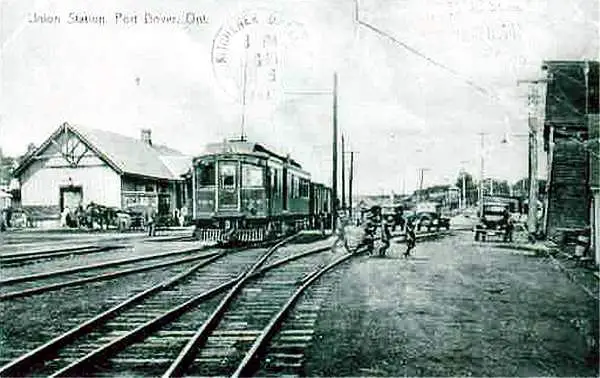 |
Port Dover about 1920 |
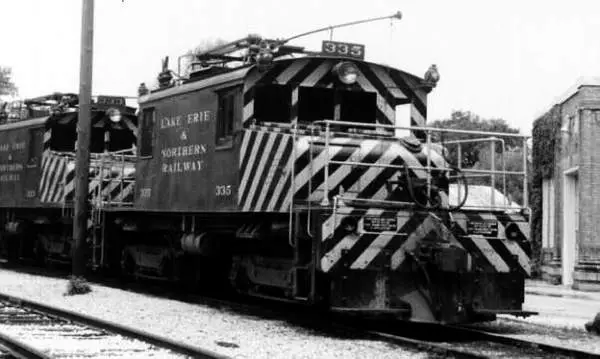 |
Tandem freight engines at Preston 1950's
Lake Erie & Northern Railway (LEN) |
|
|
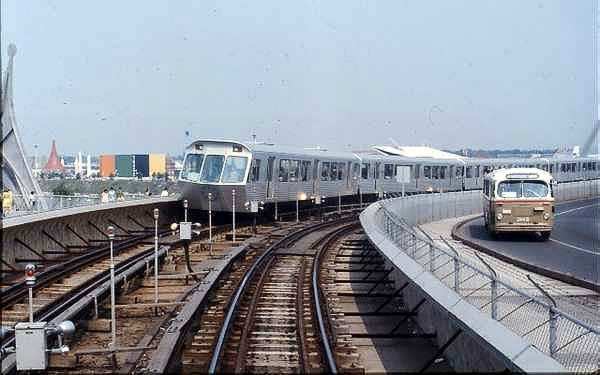 |
Many Canadians forget that the Expo Express was
the first automated system in North America, built c. 1966 for Expo 67 in Montreal, far ahead of the Vancouver Skytrain in 1985. This view shows the Expo Express, on the bridge
See the Expo Express in action at: http://www.youtube.com/watch?v=rOr1sqjdz48 For those nostalgic about Expo 67 (multiple links,
|
| This picture was taken and submitted by Massey F. Jones | |
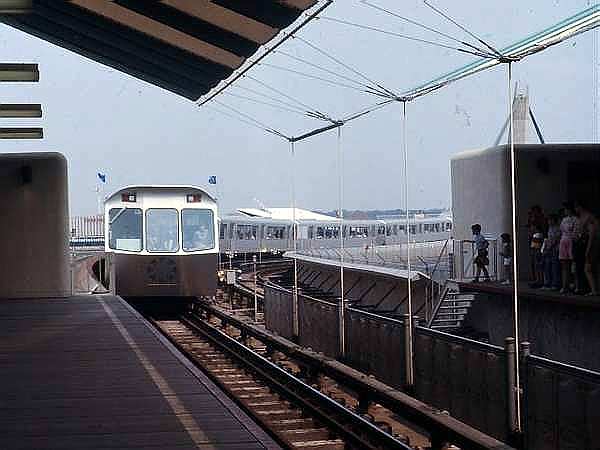 |
The Expo Express approaching the platform in July 1967.
It operated on standard gauge rail with a third rail pickup, much
like the TTC Series H cars which they resembled, except for the streamlined
front and back in the 6-car
The train was controlled by a computerized system made
Caption was edited by Martin Iftody Toronto, ON who
|
| This picture was taken and submitted by Massey F. Jones | |
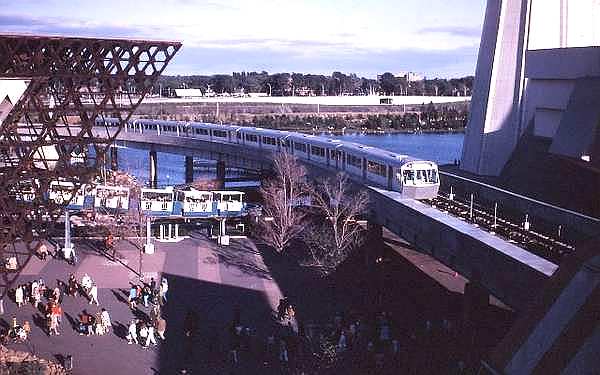 |
The Expo Express operated between Ile Notre Dame and
La Ronde from April 1967 to October 1972. This view from a high vantage point, shows the Expo
|
| This picture was taken and submitted by Massey F. Jones | |
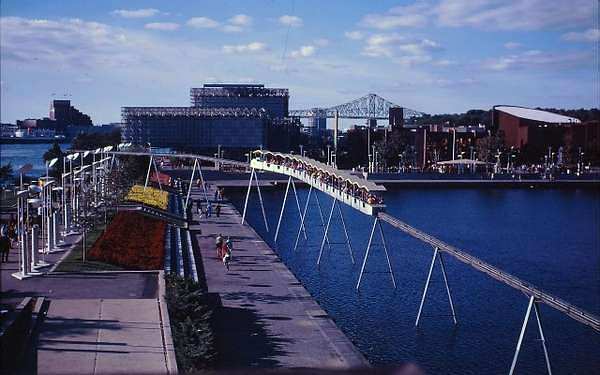 |
Other than the Minirail Bleu (Blue line), there
was the lesser Minirail Jaune (Yellow line), which operated in two loops, here in July 1967. The Jacques Cartier Bridge is in the background, linking the Montreal Island to the South Shore. Railfans will want to read an excellent description of all the Expo 67 minirail system and Expo Express from the rail viewpoint at: http://www.exporail.org/can_rail/Canadian%20Rail _no192_1967.pdf |
| This picture was taken and submitted by Massey F. Jones | |
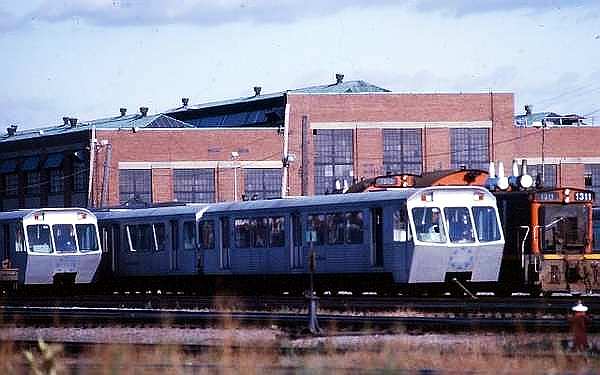 |
After Expo 67, the Expo Express continued to be in
service more or less in service until 1972, while several proposals were considered for their future. After this period, the cars were mouthballed on-site
Their last resting place was a secure area for rail
|
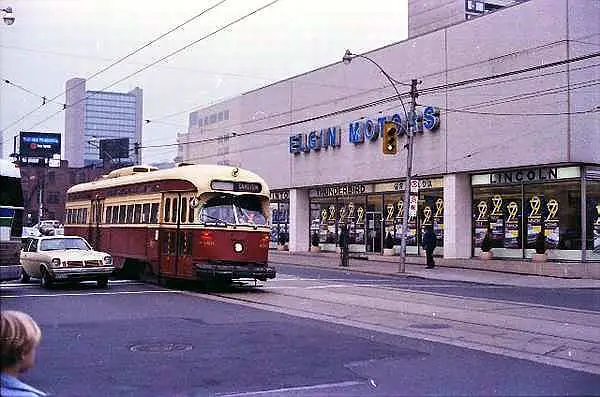 |
TTC 4369 in front of Elgin Motors, a noted Toronto landmark at 655
Bay St around 1975.. Note the
"Short Turn" sign in the front window at the entrance. The site today is an 18-storey multi-tenant building. |
||||||||||||||||||||
| This picture was taken and submitted by Massey F. Jones | |||||||||||||||||||||
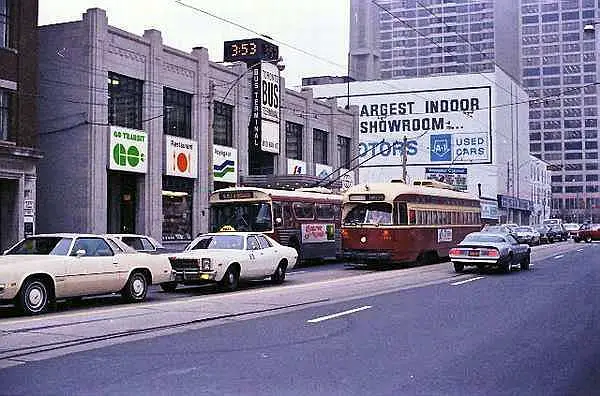 |
TTC 4369 just passing by the Toronto Coach Terminal
at 610 Bay Street, around 1975, with a Flyer trolleybus alongside. The building today has changed very little 30 years later, except that signs in front have been removed. |
||||||||||||||||||||
| This picture was taken and submitted by Massey F. Jones | |||||||||||||||||||||
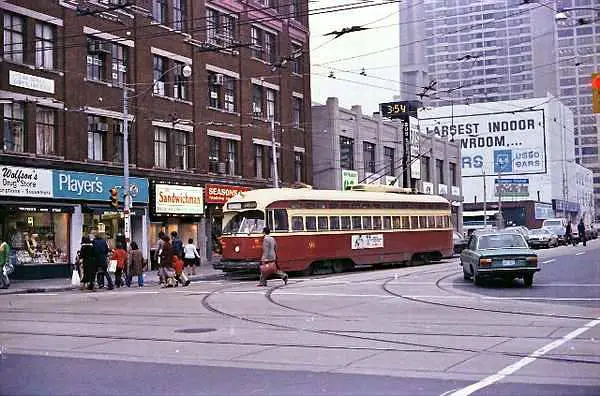 |
TTC 4369 at Bay and Dundas in downtown Toronto.
The car was built in 1946 by the Canadian Car & Foundry. Compare the corner today, with the current Google Street View. |
||||||||||||||||||||
| This picture was taken and submitted by Massey F. Jones | |||||||||||||||||||||
 |
TTC streetcars 4417 and 4315 in downtown Toronto around 1975 seen
from a Queen Street overpass.
PCC (Presidents" Conference Committee) streetcars lovingly called "Red Rockets" in Toronto (because of their fast acceleration), served the city from 1938 until 1996. TTC had purchased well over 750 of them and they proved highly reliable; transporting hundreds of millions of passengers over their years of service. In the early 70s Toronto Transit decided to decommission all of their streetcar fleet and the majority of PCCs ended up in the Wychwood carhouse graveyard, being stripped for parts: http://transit.toronto.on.ca/streetcar/4005.shtml , including the two seen here. A few PCCs were rebuilt from the ground up and renumbered in the 4600 series (A-15) after a group of citizens persuaded the TTC to retain its street car service and, for a while, the PCCs toiled along their more up-to-date counterparts, the CLRV and the ALRV in revenue service. As the eighties rolled around, it was thought to now use the PCCs on a proposed waterfront line but it wasn't found practical. A few PCCs then found new homes in museums or as tourist attractions in various cities http://transit.toronto.on.ca/streetcar/4509.shtml while some others ended up as restaurants or a place that could use the car body. http://transit.toronto.on.ca/streetcar/4006.shtml An iconic design, the PCC streetcar in various forms still runs in various places around the world. Read all about PCC streetcars at: http://en.wikipedia.org/wiki/PCC_streetcar
|
||||||||||||||||||||
| This picture was taken and submitted by Massey F. Jones | |||||||||||||||||||||
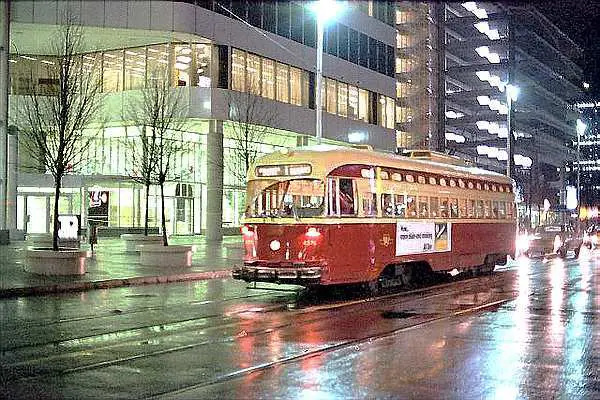 |
Red Rocket TTC 4376 on the Dundas Route in
Toronto, on a rainy night in the mid-70s. Of the 745 PCC streetcars the TTC owned - the largest
4376 was part of an A-6 order from the Canadian
|
||||||||||||||||||||
| This picture was taken and submitted by Massey F. Jones | |||||||||||||||||||||
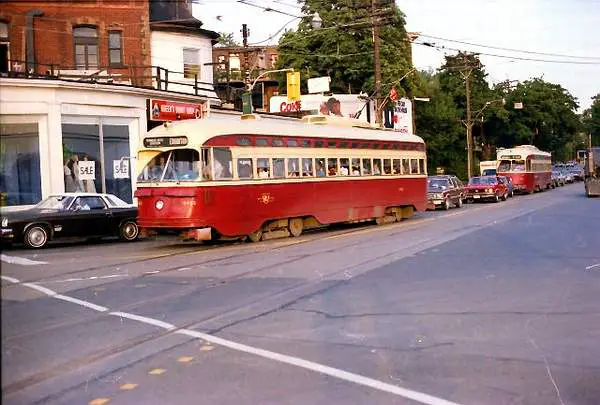 |
"Red Rocket" TTC 4403, on one of the Toronto streets
in the mid-70s. The number has now been assigned to a brand new TTC unit. View a VIMEO of the delivery of the "new 4403" done by brand new CPR locomotives 2254 and 2268 at http://vimeo.com/97552248 The new Bombardier Flexity Outlook 4403 Streetcar is taken for a test ride at Hillcrest Yard https://www.youtube.com/watch?v=4kobScpQIMI |
||||||||||||||||||||
| This picture was taken and submitted by Massey F. Jones | |||||||||||||||||||||
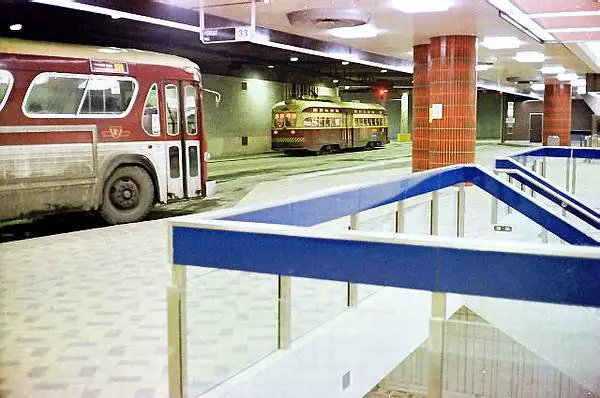 |
One of Toronto's "Red Rockets" is just departing the underground
St Clair West station in this mid 70s shot, scanned from a negative.
At that time, Massey was stationed at the airforce
|
||||||||||||||||||||
| This picture was taken and submitted by Massey F. Jones | |||||||||||||||||||||
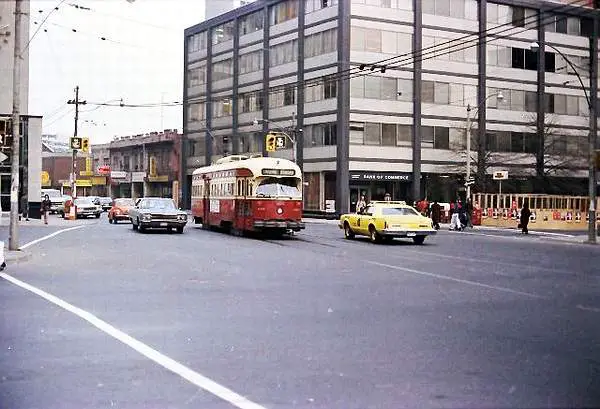 |
A typical street scene in Toronto in the mid-70s.
Notice the yellow police car beside TTC 4374 and the
|
||||||||||||||||||||
| This picture was taken and submitted by Massey F. Jones | |||||||||||||||||||||
.jpg) |
Boarding a "Red Rocket" on the KING route, off the sidewalk, mid-70s.
Notice a typical TTC car stop on the pole to the left. |
||||||||||||||||||||
| Massey F. Jones collection | |||||||||||||||||||||
.jpg) |
One of the TTC "Red Rockets" has just passed
an Eaton's store in the mid-70s. Both of them now belong in the history books. |
||||||||||||||||||||
Massey F. Jones collection
|
This series of ten pictures were taken and submitted
byMitchell Libby. They were taken at various sites of the old Toronto Transit
Comminsion's street railway cars.
In the early 1970s the TTC’s PCC fleet, which had been the world’s largest, was 20-25 years old and showing the effects of heavy service on Toronto’s streets (the last Peter Witt cars were retired from regular service in 1963).
TTC management had prepared a plan for the orderly abandonment of all streetcar service by 1980. Their rationale was that the newest PCCs (delivered in 1951) would have reached the end of their economical service lives by then. European designs were not considered suitable for Toronto operating conditions. However, neither the TTC nor Toronto City Council were anti-streetcar, as had been the case in cities such as Vancouver or Montreal; they were simply reacting to perceived circumstances. At this point, concern for the environment was growing rapidly, and many people in Toronto questioned the wisdom of replacing clean, high-capacity streetcars with polluting diesel buses. A citizens group, the Streetcars for Toronto Committee, felt that there was a viable alternative to abandonment, and in 1972, convinced City Council to instruct the TTC to cancel that plan. The Commission agreed to undertake a major overhaul of 173 of its best PCCs over a three-year period, and to investigate the purchase of 200 new streetcars to replace the rest of the PCCs.
|
||||||||||||||||||||
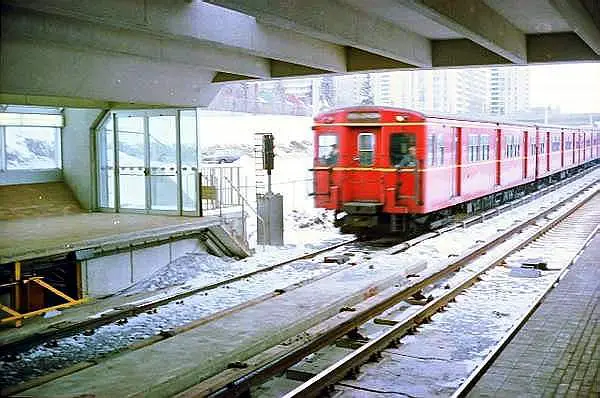 |
The first cars to be placed in service on the Toronto
subway to augment the surface "Red Rocket" cars were the G-Series cars, so called because they were built by the Gloucester Railway Carriage and Wagon Company for the Toronto Transit Commission. They entered service sometime in the early 1950s This view shows one entering one of the Bloor-Danforth subway station
(probably Old Mill) outbound from
They ran in "married pairs" (4, 6 or 8 cars) and were described as
"extremely robust". A total of 140 cars
Only one pair survives intact today at the Halton County Radial Railway in Milton, Ontario, about 25 miles (40 km) west of Toronto. |
||||||||||||||||||||
| This picture was taken and submitted by Massey F. Jones | |||||||||||||||||||||
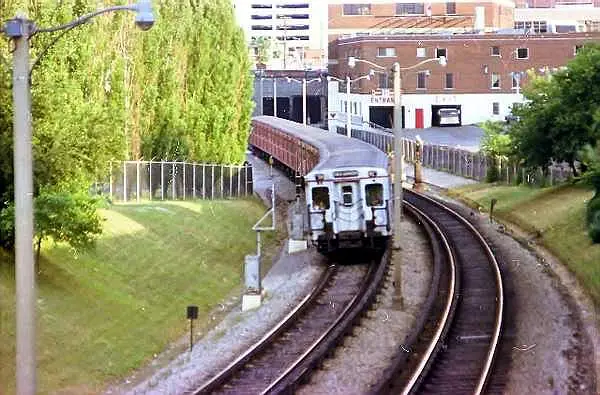 |
Six of the G Series cars (G-2) had aluminum bodies
instead of steel. We see one here, leading a string of red G-1 cars near Rosedale subway station, in the 1960s. Rosedale at that time was one of only a few places
|
||||||||||||||||||||
| This picture was taken and submitted by Massey F. Jones |
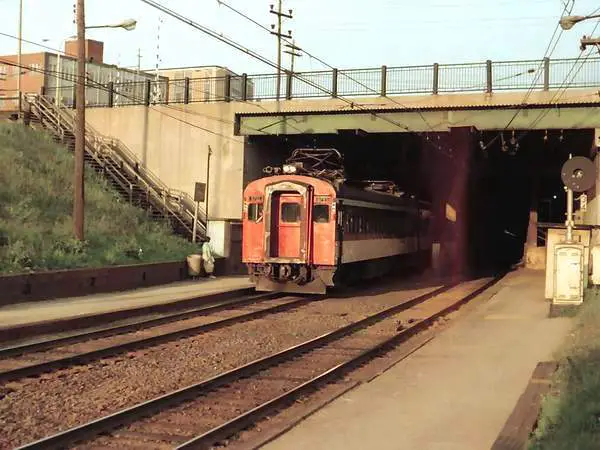
|
|
|
| This pictures were taken and submitted by Massey F. Jones | ||
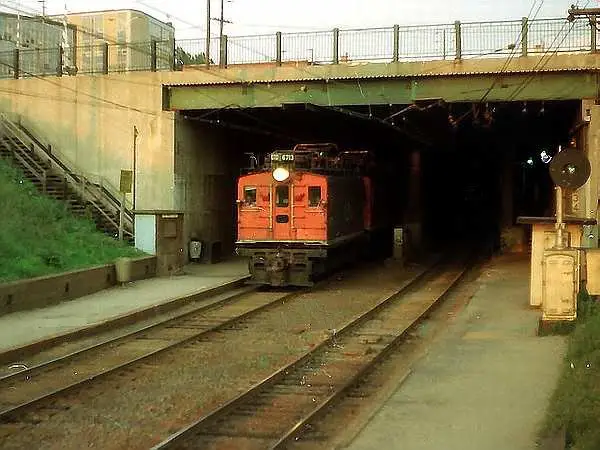 |
A CN commuter train powered CN 6713 and one
more
electric boxcab exits the tunnel under Mont Royal at the Portal Heights station of the Mount Royal Tunnel, on the Central Station (Montreal)-Deux-Montagnes commuter line around 1975. The street above is Rue Jean Talon Ouest and to the right is the eastern edge of the Town of Mount Royal (Ville Mont-Royal), which has its own station further up the line. The GE boxcabs were manufactured in 1914-17
and
In 1995, CN abandoned the commuter service
altogether
All the GE boxcab electrics were preserved,
except CN 6713. Among those preserved,
|
|
| This pictures were taken and submitted by Massey F. Jones | ||
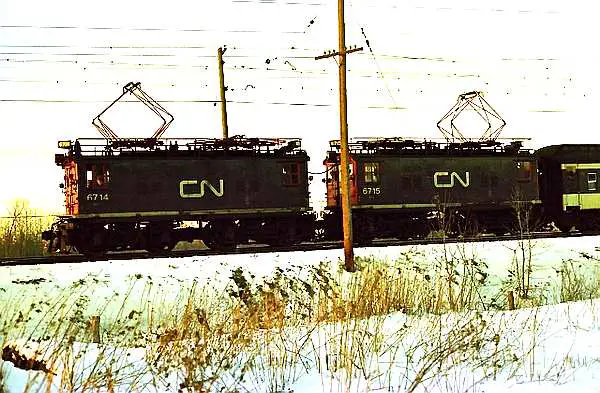 |
Boxcab electric CN 6714 and CN 6715 lead a
string
of conventional coaches northbound, on the Montreal to Deux-Montagnes line from Gare Centrale/Central Station through the Mount Royal Tunnel. The fleet, composed of 6 (6710-6715) was mainly
used
Photo: Massey F. Jones
|
|
| This pictures were taken and submitted by Massey F. Jones | ||
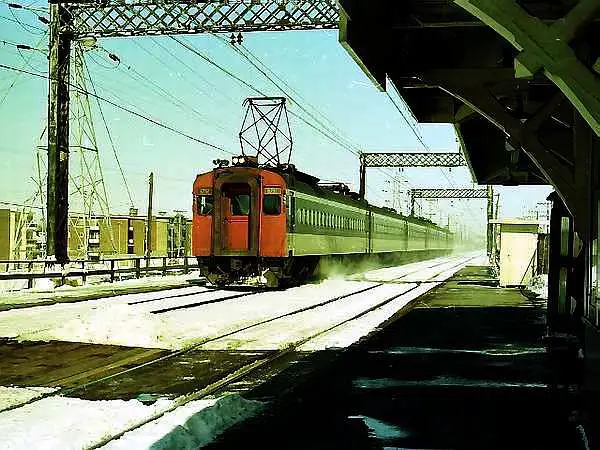 |
CN 6732, an MU electric, approaching the CN
VAL ROYAL
commuter station on north-end Montreal in 1972. The street below is Rue Grenet, where Massey lived for awhile, while being posted with the RCAF at Canadair, nearby on a project. The station, featuring a pot-bellied stove in the centre of the waiting room, has since been destroyed. The MUs, added to the CN roster in 1952
were numbered
Very fast on the acceleration, the MUs ran
on 2,400 volts
All of the units were taken out of service
in 1995 and the line
|
|
| This pictures were taken and submitted by Massey F. Jones | ||
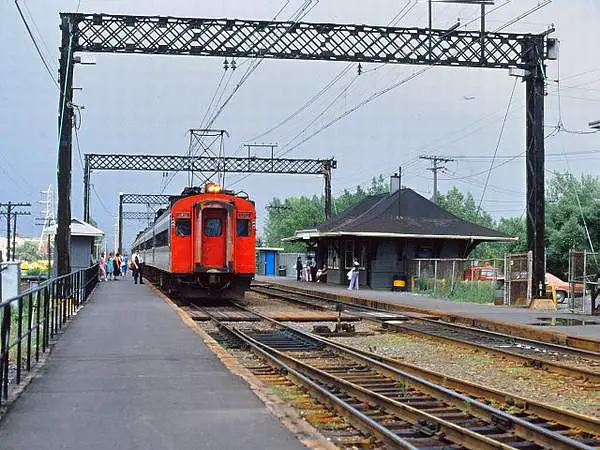 |
The CN Val-Royal commuter station near Rue Grenet
in the St-Laurent District of Montreal dates back to 1918 and the Canadian Northern Railway (CNoR), which ran a line between Gare Centrale/Central Station in downtown Montreal and St-Eustache (renamed Deux-Montagnes), with electric locomotives. CN took over operations in 1923, to about 1993. Its original name was Lazard, after the banking concern
In addition to serving commuters on the Montreal-Deux-Montagnes mainline,
a small yard beyond
The Deux-Montagnes line underwent great changes in
Almost at the same place, the new operators built a stop
|
|
| his pictures were taken and submitted by Massey F. Jones | ||
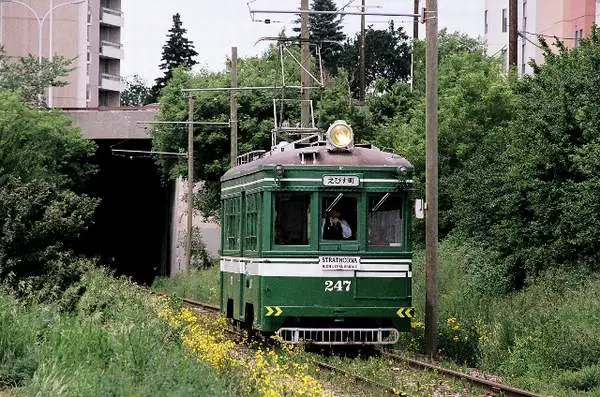 |
This tunnel passes under some apartments in
South
Edmonton on the old CPR right of Way, now called "The Ribbon of Steel" designated by Alberta Infrastructure and the City of Edmonton for the preservation of streetcar rail in Edmonton. The corridor formerly linked the South Edmonton
|
|
| This pictures were taken and submitted by Massey F. Jones | ||
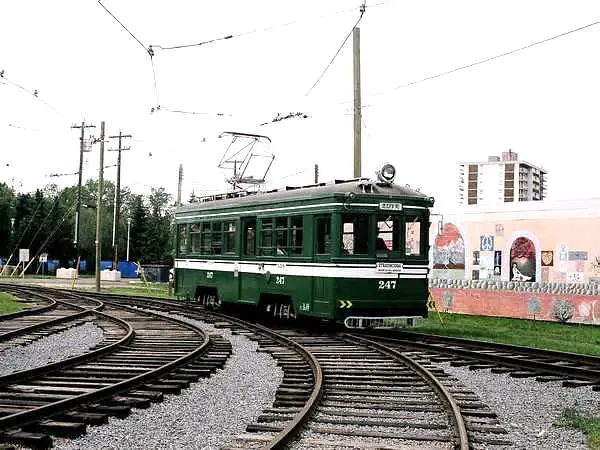 |
After having crossed the High Level Bridge, Osaka
247 arrives at the Edmonton Radial Railway Terminus at Gateway Blvd (103 St) at 84 Ave in South Edmonton (Strathcona) in the vicinity of the Farmer’s Market in 2006. The curved tracks lead into the car barn. One of a handful of streetcars operated by volunteers
http://www.edmonton-radial-railway.ab.ca/
|
|
| This pictures were taken and submitted by Massey F. Jones | ||
-Feb7.jpg) |
The interior of Osaka #247 is sparse but functional.
Notice the absence of virtually any comfort. The streetcar is mostly designed to handle standing crowds, rather than seated passengers and served Osaka residents well. The Edmonton Radial Railway Society purchased it for
|
|
| This pictures were taken and submitted by Massey F. Jones | ||
-Feb7.jpg) |
The strap hangers and Japanese language signs
have been preserved inside Osaka #247. It was built in 1921 and rebuilt in 1947 following WWII.
http://www.edmonton-radial-railway.ab.ca/streetcars/
|
|
| This pictures were taken and submitted by Massey F. Jones | ||
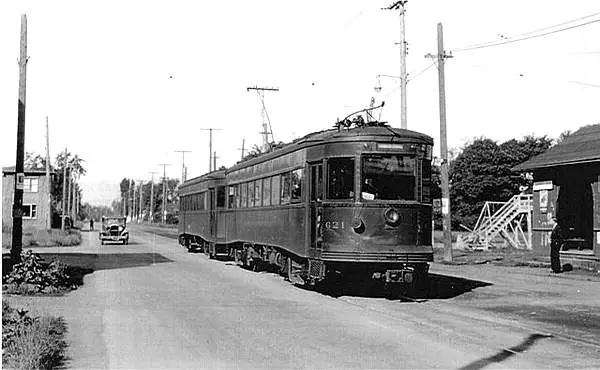 |
Electric tram #621 of the Montreal and Southern Counties proceeding
east on Churchill Blvd. at the corner of Empire
Ave. in Greenfield Park. The tram #621 was one of the later models used by the railway before the tracks were pulled up about 1956 because of competition from the Chambly Bus Company. To the right of the tram you can see part of one of the two Greenfield Park stations that protected passengers for more than thirty years. The other station was near the corner of Devonshire Road (now called Victoria Ave.) The playground of Empire Park is also partially visible. Where the playground once stood you'd now find the modern Greenfield Park Library. |
|
| This picture was submitted by John Riley and was taken about 1950 and is part of the Graham MacDonald collection. | ||
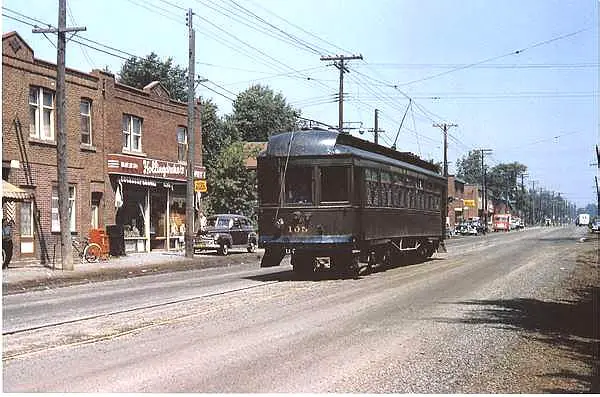 |
Montreal and Southern Counties tram photos taken in Greenfield Park.
The first is tram 105 traveling west along Churchill Blvd. and has just
passed the corner of Springfield Ave. To the left of the tram you can see
the Hollingdrake Building dominated by Hollingdrake's Store. To the right
of
the electric railway car you can see towards Fairfield Ave. and in the distance Taschereau Blvd. The photo is from 1955 and is part of Normand Simard's collection of trams and trains. |
|
| This picture was submitted by John Riley. The photo was taken in 1955 and is from the Normand Simard collection. | ||
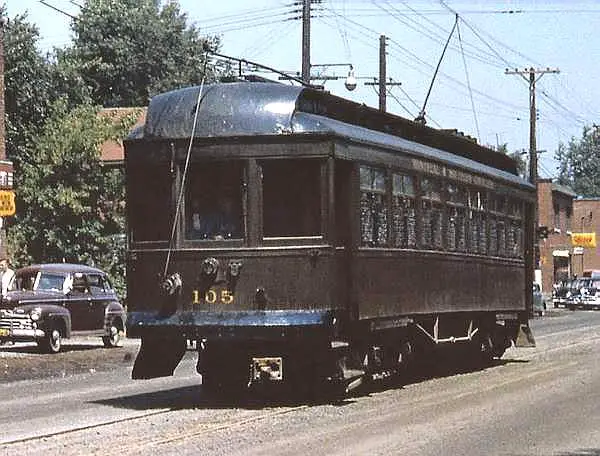 |
||
| This picture was submitted by John Riley. The photo was taken in 1955 and is from the Normand Simard collection. | ||
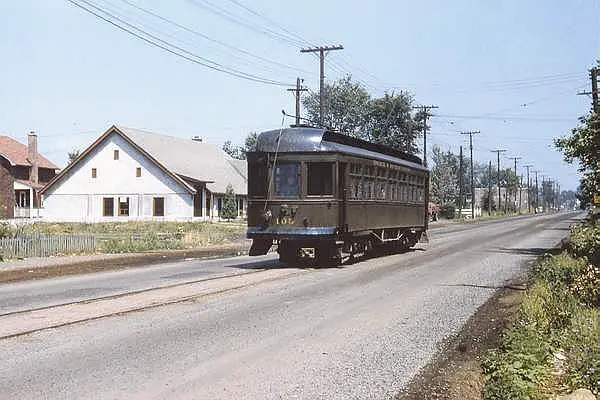 |
Montreal & Southern Counties tram No. 105 on
Churchill Blvd. in Greenfield Park heading west after passing the corner of Murray Ave. The white building to the left of the tam is the Pentecostal Church. In the distance to the right is a gray colored building called the Perras Building. The tram is approaching the corner of Devonshire Road (now called Victoria Ave. |
|
| This picture was submitted by John Riley. The photo was taken in 1955 and is from the Normand Simard collection. | ||
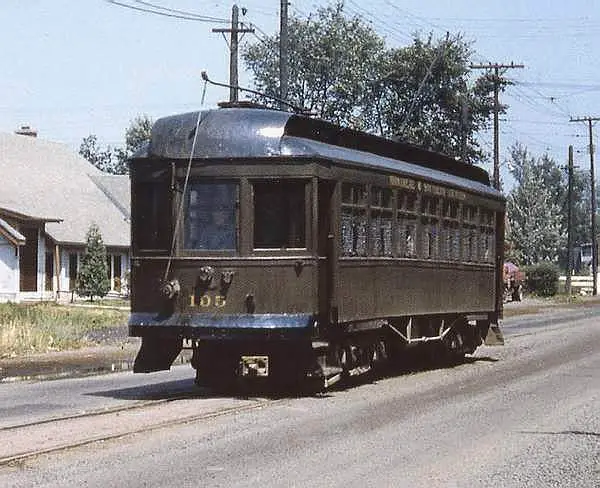 |
||
| This picture was submitted by John Riley. The photo was taken in 1955 and is from the Normand Simard collection. | ||
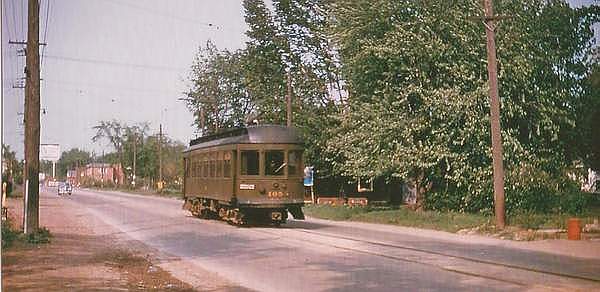 |
This photo dating from 1953 shows Montreal & Southern Counties
tram No. 105 traveling west on Churchill Blvd. in Greenfield Park between
Hubert St. and Murray Ave.
The tram has just passed St. Anastase Church (not visible), the pinkish colored brick building in the distance on the left is the Letourneau Building, and the white doors to the left of the approaching car are those of the Greenfield Park Fire Station on the corner of Springfield Ave. and Churchill. |
|
| This picture was submitted by John Riley. The photo was taken in 1955 and is from the Normand Simard collection. | ||
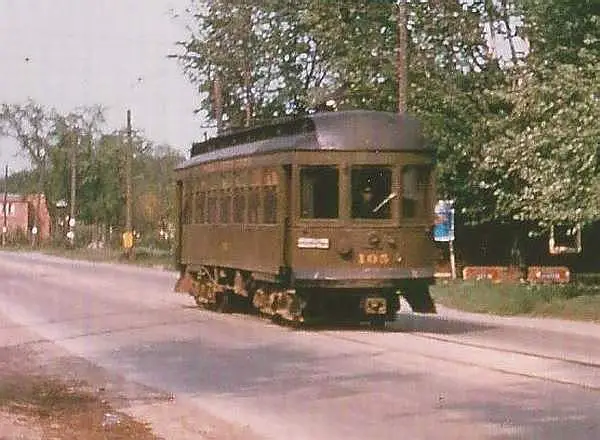 |
||
| This picture was submitted by John Riley. The photo was taken in 1955 and is from the Normand Simard collection. | ||
-Feb7.jpg) |
Edmonton Radial Railway Society #42, passing
through the 1905 Street in front of the Masonic Hall Museum in Fort Edmonton. The top floor contains the Masonic Lodge – Ivanhoe artifacts while food services are on the bottom floor. The streetcar operates on a loop track within
View the streetcar track layout at http://fortedmontonpark.ca/wp-content/uploads/2013/03/
|
|
| This pictures were taken and submitted by Massey F. Jones | ||
-Feb7.jpg) |
The interior of ERRS streetcar #42.
Notice the period signs, overhead on each side and
In this type of streetcar, the operator also has his own
|
|
| This pictures were taken and submitted by Massey F. Jones | ||
-Feb7.jpg) |
Already into the the Edmonton Radial Railway paint
scheme, this car, sitting at the ERRS main workshop at Fort Edmonton in July 1994, just need finishing touches by a team of dedicated volunteers who like to refinish old streetcars. The Edmonton Radial Railway (which the society is
|
|
| This pictures were taken and submitted by Massey F. Jones | ||
-Feb7.jpg) |
This wreck, seen here at Fort Edmonton in July
1994 near the ERRS workshop, will eventually be lovingly restored to pristine condition inside and out by members of the Edmonton Radial Railway Society as one of their operational streetcars. http://www.edmonton-radial-railway.ab.ca/streetcars/ future_projects/ |
|
| This pictures were taken and submitted by Massey F. Jones | ||
-Feb7.jpg) |
Edmonton Radial Railway volunteers like to fix old
streetcars at their Strathcona car shop in South Edmonton and these two, which are periodically run on the High Level Bridge, are no exception. The Strathcona car shop houses those running on the High Level Bridge, while the main workshop at Fort Edmonton accommodates those running within the Park. On the left is Hannover # 601 http://www.edmonton-radial-
|
|
| This pictures were taken and submitted by Massey F. Jones | ||
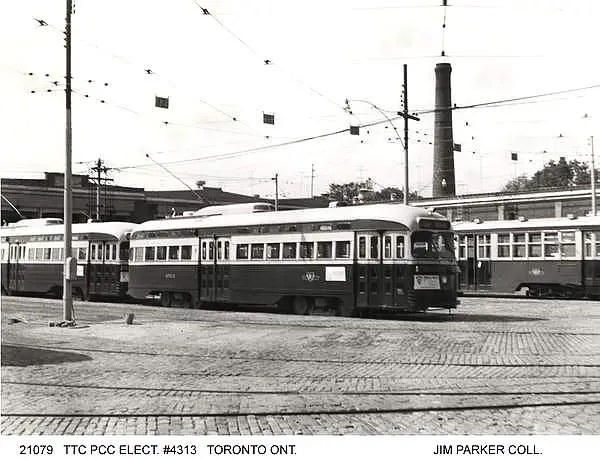 |
TTC (Toronto Transit Commission) PCC Electric
#4313
at Toronto Ont. The
PCC (Presidents' Conference Committee) streetcar
|
|
| This picture was submitted by Jim Parker and is part of "The Jim Parker Collection" | ||
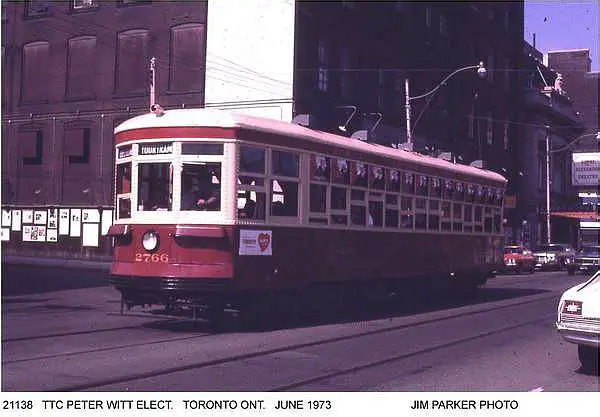 |
TTC (Toronto Transit Commission) #2766 Peter
Witt Electric Streetcar at Toronto Ont. June 1973 Mr.
Witt completed the first prototype in 1914 and filed
|
|
| This picture was taken and submitted by Jim Parker | ||
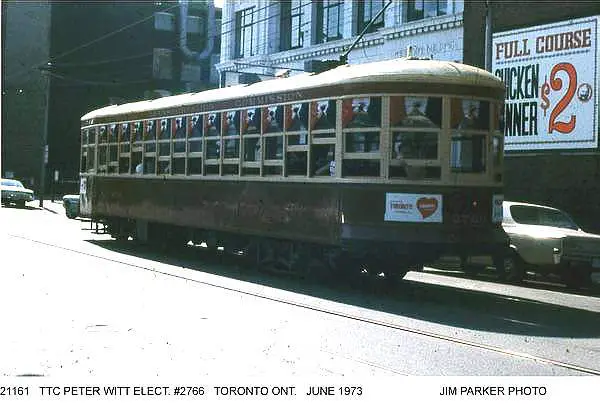 |
TTC (Toronto Transit Commission) #2766 Peter
Witt
Electric Streetcar at Toronto Ont. June 1973 |
|
| This picture was taken and submitted by Jim Parker | ||
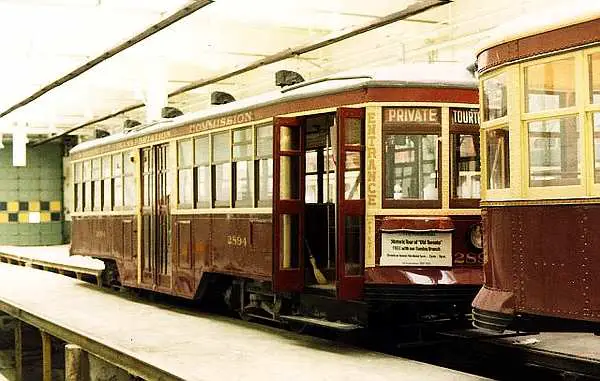 |
Back in 1972, while everyone was converting
to diesel
buses, the Toronto Transit Commission (TTC) decided to keep its streetcars and refurbished some of their PCC streetcars (shown on this page). It was then proposed to also add some of their older pieces of equipment for tourist service. Peter Witt streetcars 2894 and 2766 were reconditioned.
2894 is at the TTC Russell carhouse on 15 Oct
1978
The car in front of the 2894 of the lineup
is 2424, described below. Read all about the TTC Peter Witt streetcars
at: http://transit.toronto.on.ca/streetcar/4501.shtml
|
|
| This pictures were taken and submitted by Massey F. Jones | ||
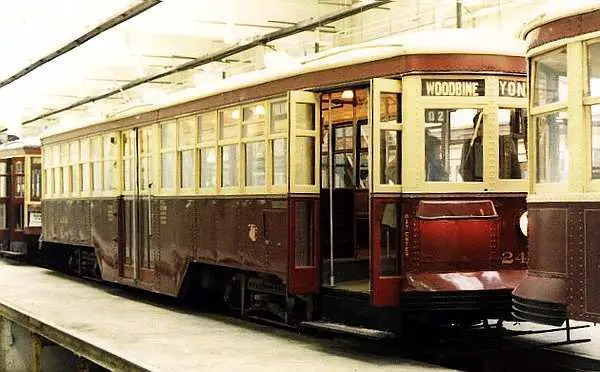 |
Now operating nights and weekends and a bit
further
afield within the downtown periphery on charters, TOURTRAM proved to be fairly successful. Faced with an increased ridership in 1975, TTC required an extra car for its operation, complementing their 2894 and 2766 already in service. It then looked to the Halton County Radial Railway Museum at Milton, Ontario for a new car and "Large Witt" 2424 was found suitable. Built by the Canadian Car & Foundry
in 1921 as a
This photo shows the TTC 2424 at Russell carhouse
View the history of the Beltline service at:http://transit.toronto.on.ca/streetcar/4131.shtml
|
|
| This pictures were taken and submitted by Massey F. Jones | ||
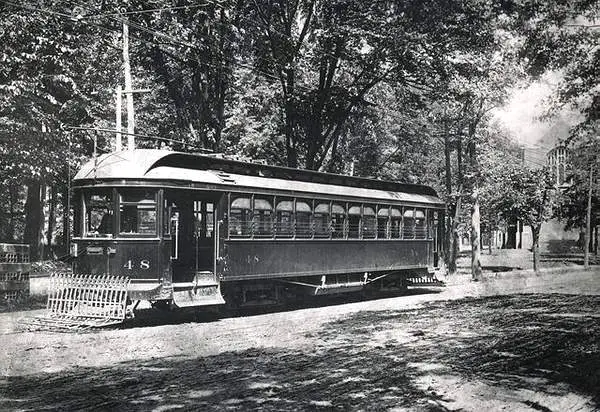 |
Toronto & York streetcar #48, circa 1918, outside
city limits at Yonge Street and Lawton Blvd, (just north of St Clair Avenue East) in 1918. Research puts the car in Deer Park (Lawton Park), with Christ Church (Anglican) in the background to the right. http://lostrivers.ca/content/points/lawtonpark.html # 48 was manufactured by the Preston Car & Coach
|
|
| Massey F. Jones collection | ||
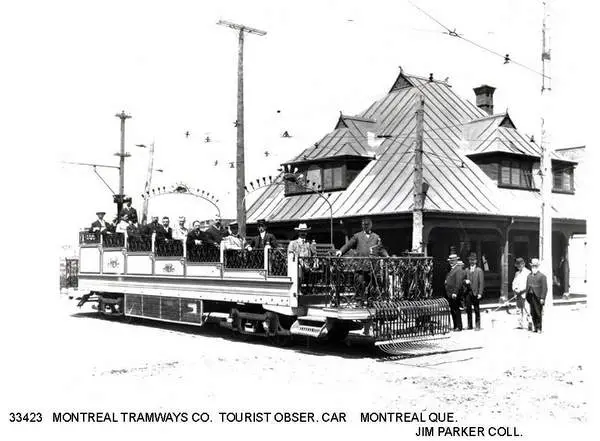 |
Montreal Tramways Co. Tourist Observation car
Montraeal Quebec, aprox 1905 |
|
| Jim Parker Collection | ||
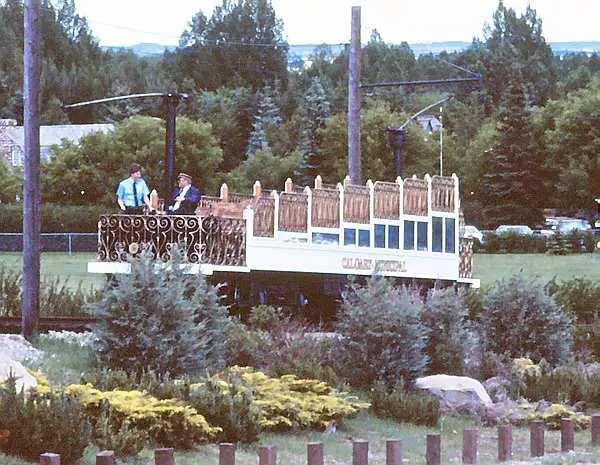 |
The Canadian Railway Museum (now Exporail) at
St Constant QC, leased Montreal observation car No 3 to Heritage Park in Calgary for a number of years where it was lettered "Calgary Municipal". Here, during the 1984 summer season, it is taking passengers from 14 St SW and Heritage Drive to the Park's main gate a kilometer away, instead of one of their regular streetcars. It was returned to Exporail in 1991. Montreal Tramways No 3 was one of four of that type
In 1905, it cost 25 cents to ride, 6 times the regular fare
Their last day of operation was Aug 30, 1959, when No 2 participated
in the final ceremonial parade, when one of
|
|
| This pictures were taken and submitted by Massey F. Jones | ||
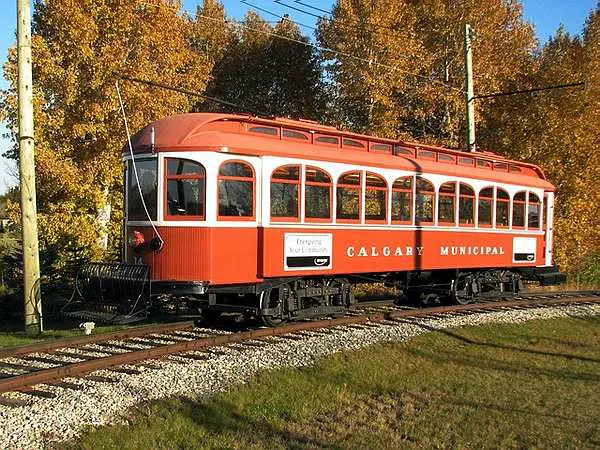 |
Calgary Municipal No 14, more familiarly called the
Heritage Park Streetcar and formally known as The ENMAX Electric Streetcar System; heading home empty on the last trip of the season, October 14th 2013 around 5:00 pm. Car 14 was the very last streetcar to run in Calgary,
More streetcar parts were found and donated to
|
|
| This pictures were taken and submitted by Massey F. Jones | ||
|
|
The double-door setup of Heritage Park cars 14 and 15,
also called by some “a Prairie Style Door”. The other side at the back is identical. Thomas Henry McCauley, superintendent of the Calgary electric streetcar
railway, from the beginning in 1909 to
The door mechanism patent was filed on 5 June 1917
The Patent also made its way to the States as US 1249976 http://www.google.com/patents/US1249976
|
|
| This pictures were taken and submitted by Massey F. Jones | ||
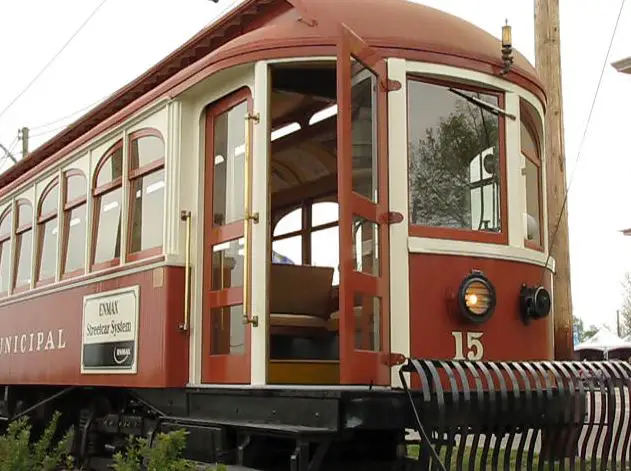 |
Car #15 with the door open | |
| This picture was submitted by Massey F. Jones | ||
| Specification of Letters Patent. Patented Dec. 11, 1917 Application
filed February 28, y1917. Serial No. 151,475.v
To all whom it may concern. Be it known that I, THOMAS HENRY MCCAULEY, a citizen of the Dominion of Canada and subject of England, residing at Calgary, in the Province of Alberta and Dominion of Canada, have invented new and useful Street-Car Doors, of which the following is a specification. The present invention relates to street car doors, and aims to provide a novel arrangement of the entrance and exit doors, providing for compactness in construction, and enabling the entrance and exit doors to be placed at the front end of the car with a short vestibule, such a vestibule being of advantage in that it will not overhang the opposite track in turning corners. The present invention also enables ordinary short vestibule single entrance cars to be converted into the double door construction, or to be equipped with the entrance and exit doors at one end in a compact arrangement. Another object of the invention is the provision of novel means for operating either or both of the entrance and exit doors, in order that they can be operated individually or jointly. It is also within the scope of the invention to provide the aforesaid improvements, which are of comparatively simple construction, which can be readily installed without prohibitive alterations or expense, .and which will increase the efficiency and utility of the car. .................. Thomas Henry McCauley also provided an invention patent for a mechanism to open and close the door from inside and retract the step while the car was running. Of note in these pictures is the large “cowcatcher”, prominent in
these days to scoop
|
This is an extract from the patent for the "Prairie" style
door on early Calgary Transit streetcars. (some typos corrected for the purpose of this caption) |
|
| Submitted by Massey F. Jones | ||
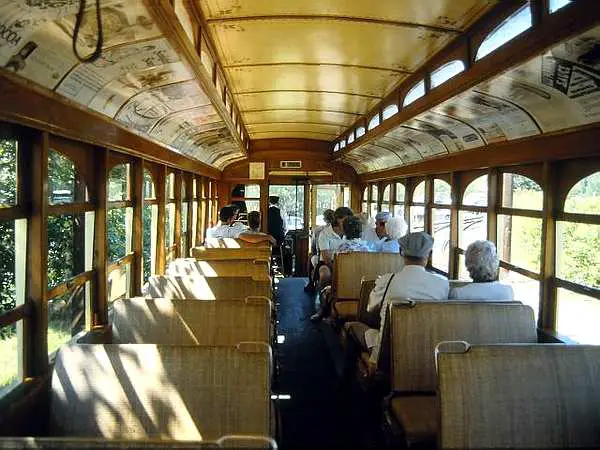 |
The interior of Heritage Park #14 or #15. The streetcars
are mostly alike inside and outside and used alternately. Streetcar operation is daily during June, July and August but weekends only at the beginning and end of the visitor season. More details and a 15-minute technical video of No 15 in action at: http://www.youtube.com/watch?v=mIF0QlU99uU |
|
| This pictures were taken and submitted by Massey F. Jones | ||
|
|
The controls on Car #15 | |
| This picture was submitted by Massey F. Jones | ||
|
|
The controler on Car #15 | |
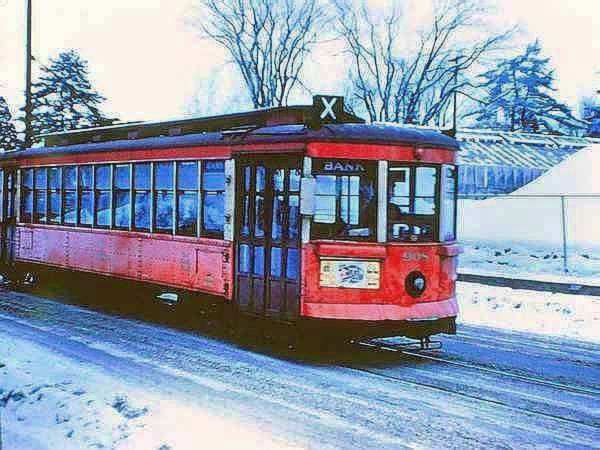 |
Ottawa Transportation Commission, or simply the OTC, streetcar #108
on Bank Street in the 1950s or so.
All Ottawa streetcars were removed from service in 1959. At the very bottom, close to the track under the anticlimber
Watch a very good 9:40-minute video of old Ottawa
The 8mm sequences, shot by a very close friend of
|
|
| Massey F. Jones collection | ||
 |
As
a tribute to the Canadian National Exhibition
celebrating its centennial in 1978, the TTC, GO Transit and other groups participated in a transportation exhibit and set up 10 vehicles on the north side of what came to be called "Centennial Square, just east of the Dufferin Gate. The
development of the streetcar was illustrated by 5
|
|
| This pictures were taken and submitted by Massey F. Jones | ||
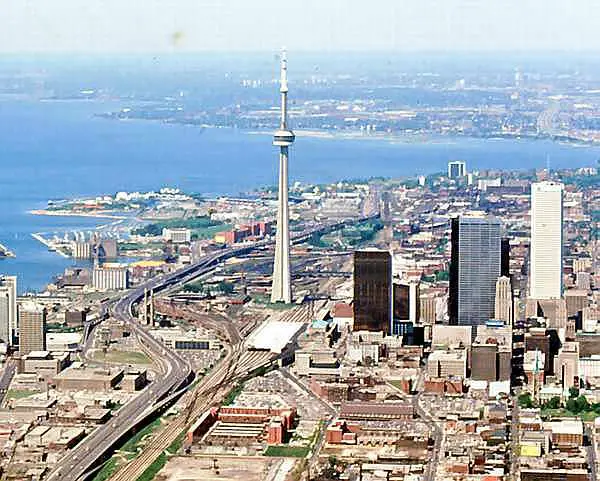 |
A blow-up of a 35mm Kodachrome slide from a series,
taken by Massey during early summer 1978 and used by the Canadian Forces for briefing Canadian National Exhibition Air Show participants. Visible in this shot, is Union Station, just about in the
|
|
| This pictures were taken and submitted by Massey F. Jones | ||
 |
Montreal Tramways 200, a Birney Safety Car,
during a visit at the Canadian Historical Railway Association (now Exporail) in the early-70s; when Exporail was in infancy as a museum. Many cities and towns used the Birney Safety Car and the company built over 4000 - all identical. Car 200 was purchased by the Montreal Tramways Company (MTC) from Detroit in 1924 and it operated on Montreal streets until 1947, notably on the Montreal North route 40 and Remembrance Road route 11, the latter on the Mont Royal, Montreal's mountain; from Lac des Castors (Beaver Lake) to Cote des Neiges. Massey frequently rode that one, during his teenage. Not all Birneys were double-end but the advantage of a double-end
trolley was that the the car didn't have to go
|
|
| This pictures were taken and submitted by Massey F. Jones | ||
.jpg) |
The interior of Montreal Tramways Car 200, at the
Canadian Historical Railway Association (now Exporail) in the early-70s. These Birney streetcars built by Brill in 1919 were
At the end of its passenger carrying life, Montreal
|
|
| This pictures were taken and submitted by Massey F. Jones | ||
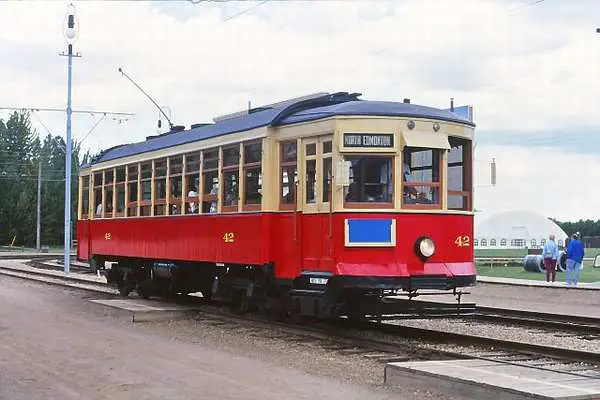 |
Edmonton Transit Car 42 at Fort Edmonton Park,
southwest of the city nearing the boarding platform after completing another run around the Park perimeter in June 1994. Almost every trip fills the car to capacity during summer months. Read all about Car 42 and other operating ERRS
|
|
| This pictures were taken and submitted by Massey F. Jones | ||
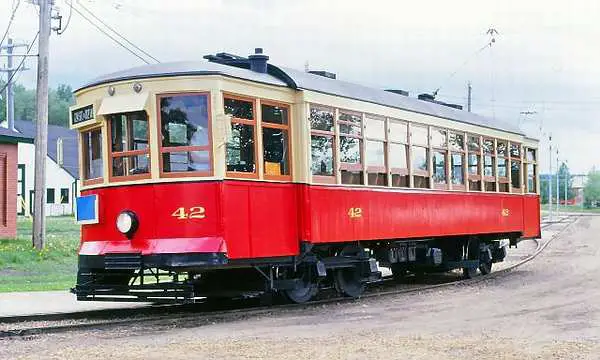 |
The body of No. 42 was recovered in 1981 and lovingly
restored by the Edmonton Radial Railway Society volunteers at Fort Edmonton Park prior to reentering service in 1984,. Others streetcars were also restored or in the process of being restored at their carbarn in Strathcona (South Edmonton). The ERRS also operates streetcars between downtown Edmonton and South Edmonton during the summer |
|
| This pictures were taken and submitted by Massey F. Jones | ||
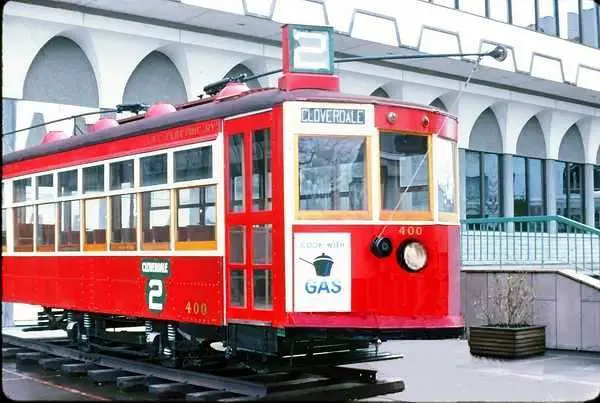 |
Birney Safety Car 400, displayed at the Provincial
Museum, Victoria BC summer 1976. In 1921, the City of Victoria placed an order with the
Car 400 served for 25 years, before being retired in
In 1990, the Nelson Electric Tramway Society brought
|
|
| This pictures were taken and submitted by Massey F. Jones | ||
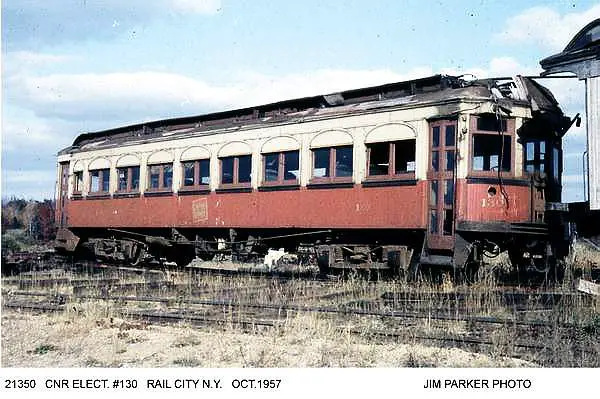 |
CNR Electric #130 at Rail City, N.Y. Oct 1957 | |
| This picture was taken and submitted by Jim Parker | ||
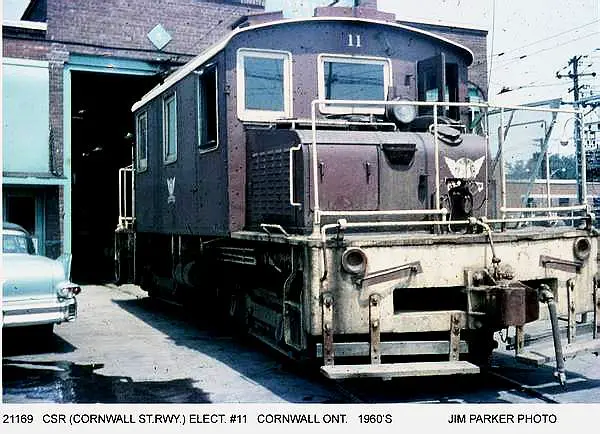 |
CSR (Cornwall Street Railway) Electric #11
at
Cornwell Ont, 1960's Cornwall
Street Railway, Light and Power
|
|
| This picture was taken and submitted by Jim Parker | ||
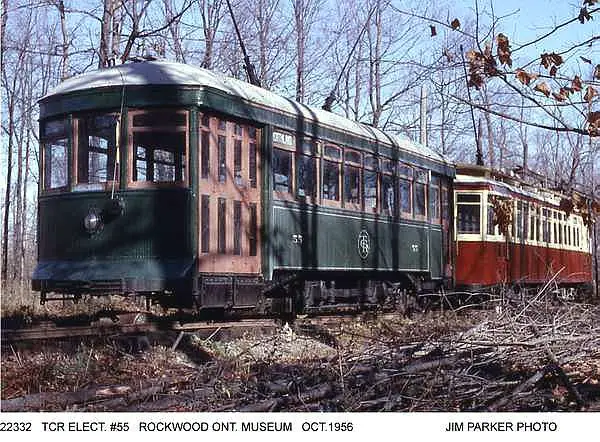 |
TCR (Toronto Civic Railway #55 at the
Rockwood Ont. Museum Oct 1956. The
Halton County Radial Railway is a working
|
|
| This picture was taken and submitted by Jim Parker | ||
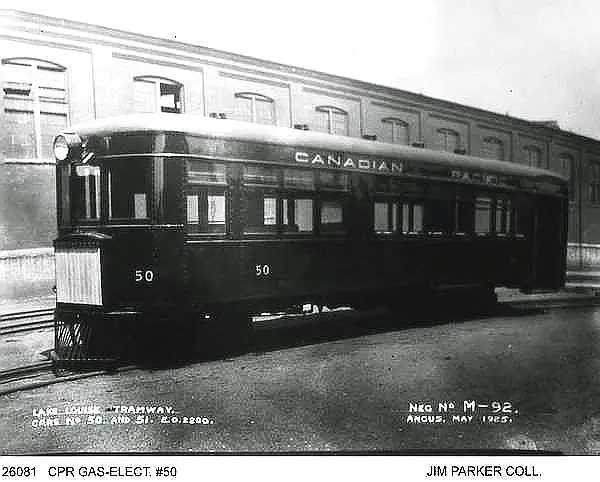 |
CP Rail gas electric #50, Lake Louise Tramway
The
Lake Louise Tramway was a unique operation like no
|
|
| This picture was submitted by Jim Parker and is part of the Jim Parker Collection | ||
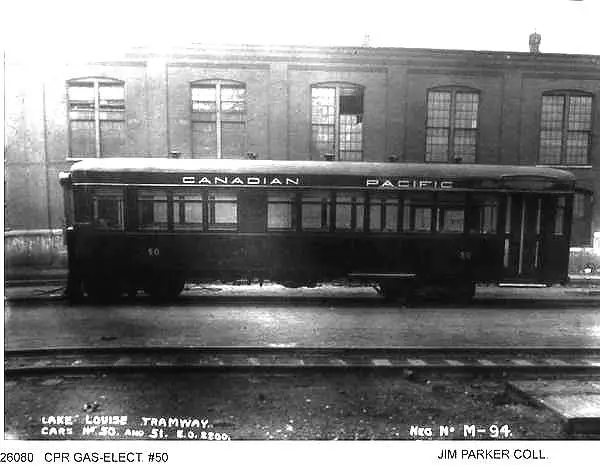 |
CP Rail gas electric #50, Lake Louise Tramway | |
| This picture was submitted by Jim Parker and is part of the Jim Parker Collection | ||
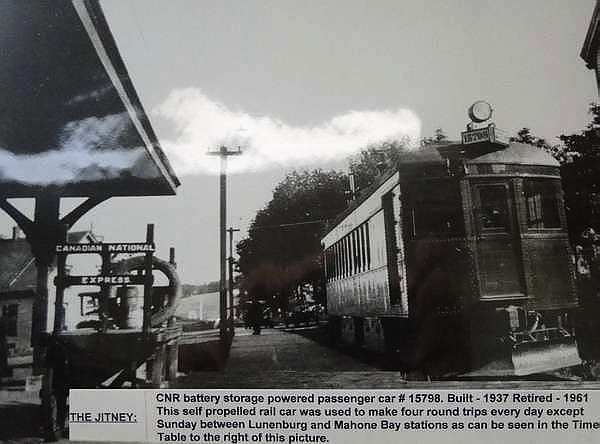 |
CNR Battery storage powered passanger car
#15798
The Jitney, built in 1937 and retired in 1961. This self propelled rail car was used to make four round trips everyday except Sunday between Lunenburg NS and Mahone Bay NS |
|
| This picture was taken at the Halifax
& Southwestern Railway Museum,
Lunenburg Nova Scotia |
| Around 1983, Massey purchased a few Calgary streetcar slides from
the Glenbow Archives, for his personal use. Glenbow Archives is situated
on the 6th floor of the Glenbow Museum, Canada's largest repository
for history of life
in Western Canada from 1870 to 2000, with an extensive collection of original books, prints, negatives and other reference material. http://www.glenbow.org/collections/archives/ The views depict the Calgary Municipal Railway (now Calgary Transit) circa 1911-1919. The captions, researched from printed and web media are accurate as possible. |
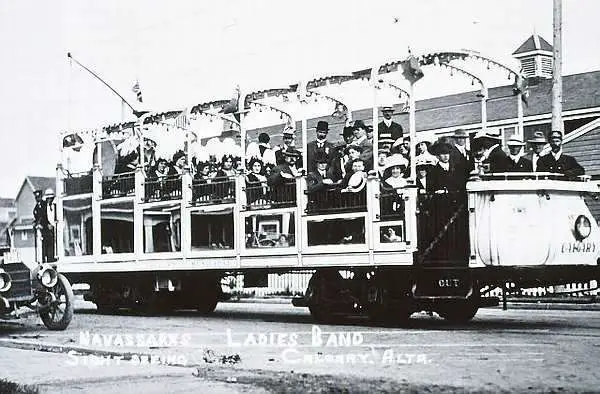 |
The pride and joy of Calgary Municipal Railway
was this Observation Car, ordered from the Preston Car and Coach Company of Preston, Ontario in 1911 as one of a kind and called it No.50, which was later given to another streetcar. It featured a striped canvas top, several lights adding to night time enjoyment and tier seating; one seat 6 inches above the one below. To Calgarians, the Observation Car wa s simply known as the Scenic Car. With no windows on the side, passengers could enjoy the open air. The canvas top had yet to be installed, as it made it's
Glenbow Archives NA-2553-5 |
| Submitted by Massey F. Jones | |
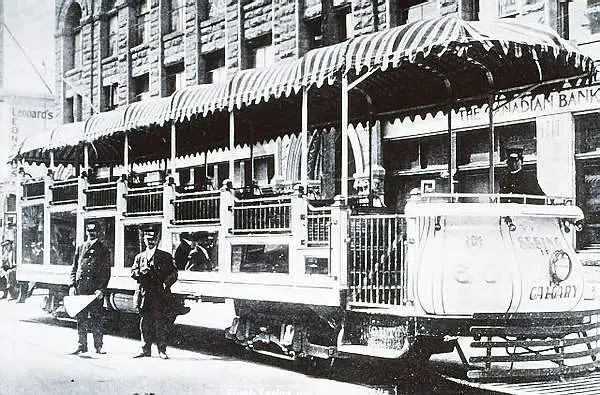 |
The number 50 can clearly be seen on the chariot-style
dash. The car is seen here on Centre Street just south of 8 Ave South, facing northbound (just about in front of the Calgary Tower today) with the conductor standing with a bullhorn for commentary. The Scenic Car was fitted with a striped canvas canopy, which could
be removed and stored under the rear seat.
Glenbow Archives NA-924-1 |
| Submitted by Massey F. Jones | |
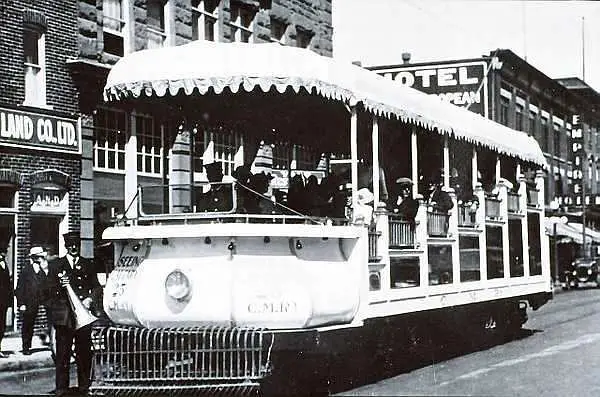 |
The Scenic Car is now on 9th Avenue SE, with
Empire Hotel in background, circa 1912. It has now lost its number on the chariot-style dash and it now reads:"Seeing Calgary 25¢" and "CMRY". With the motorman is at the controls, the conductor poses with a large bullhorn that he used during the run for commentary. He also collected the fares. No employee on the spare board was allowed to drive the Scenic Car Car. Notice the coloured lights under the dash and the large cowcatcher.
Also the original striped awning has also
Glenbow Archives NA-2813-1
|
| Submitted by Massey F. Jones | |
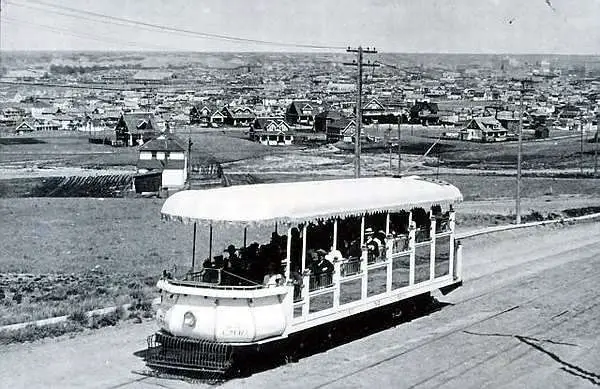 |
A one hour circle tour cost 25 cents, about 5 times the
price of a regular streetcar fare. Various circuits were available and there were about 7 departures. Some routes were changed over time but the most popular were the South Calgary route (shown here) to the highest point in the city offering a view of the Rocky Mountains and the Bowness line, offering several sylvan views along the Bow River. The Scenic Car is now on 17 Avenue SW in the vicinity
Glenbow Archives NA-2813-2 |
| Submitted by Massey F. Jones | |
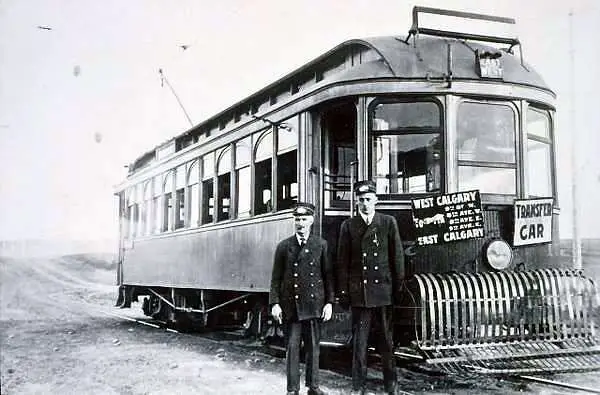 |
Calgary Municipal Railway No. 17 with its crew beside
a transfer car between West and East Calgary along 9 Avenue. The fellow to the right is Walter "Spike" Robinson. The car was built by the Preston Car Company and
Glenbow Archives NA-265-13
|
| Submitted by Massey F. Jones | |
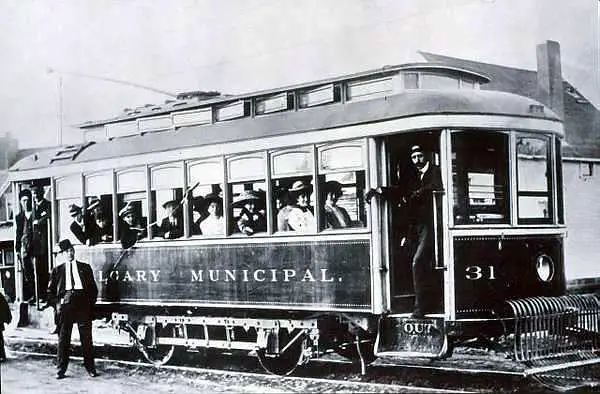 |
Calgary Municipal Railway No 31 at an unknown location.
Numbers 19-36 were single-truck cars, referred by Calgarians as "dinkies".
They were single-end with a
Glenbow Archives NA-1132-1
|
| Submitted by Massey F. Jones | |
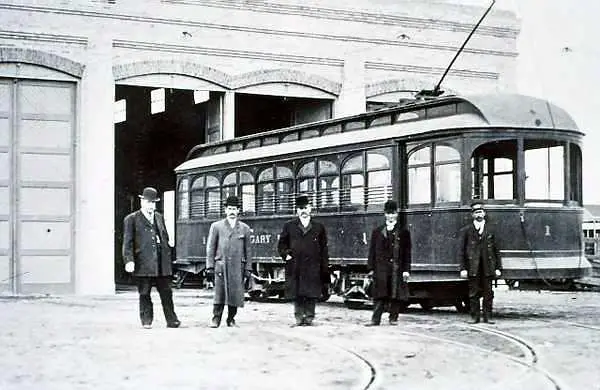 |
Car No 1 at the Calgary Municipal carbarn with some officials and
the conductor. It was built by the Ottawa
Car Company in 1909 and seated 44 passengers. Second from the right is Mr. Thomas Macauley, who
Glenbow Archives NA-2891-1
|
| Submitted by Massey F. Jones | |
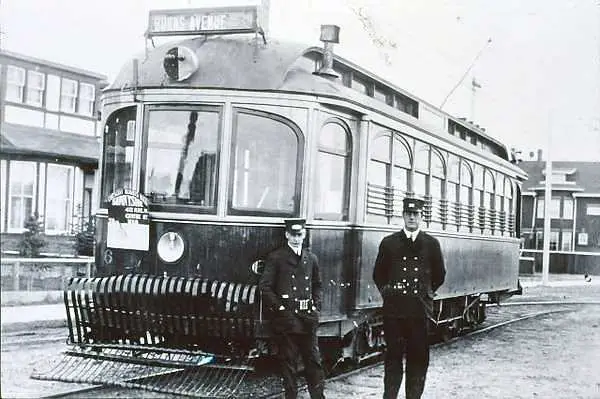 |
Calgary Municipal Railway No 6, built by the Ottawa
Car Company in 1909, on the Burns Avenue run (on the other side of the Calgary Stampede in Ramsay). Notice the horizontal bars across the windows, preventing passengers from sticking limbs outside while the car was in motion, a common practice then. The conductor collected fares and carried a change dispenser, a practice
which endured until
Glenbow Archives NA-1299-1
|
| Submitted by Massey F. Jones | |
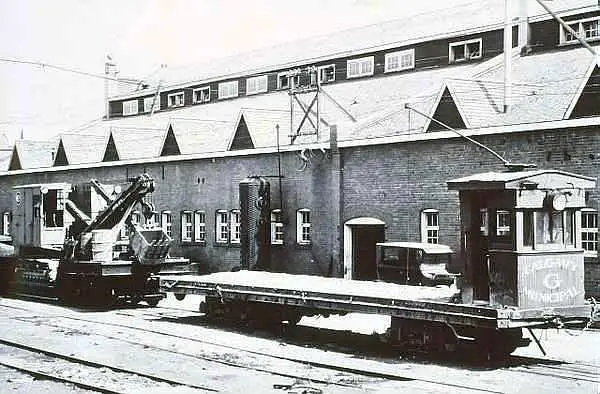 |
Calgary Municipal Railways car G started service
as a water sprinkler with front and rear cabs but was rebuilt to a 42-foot gravel dump car. The location is most probably on CMR property. The shovel behind the motor car, has been loaded on to a low centre of gravity flatcar. Glenbow Archives NA-2891-22
|
| Submitted by Massey F. Jones | |
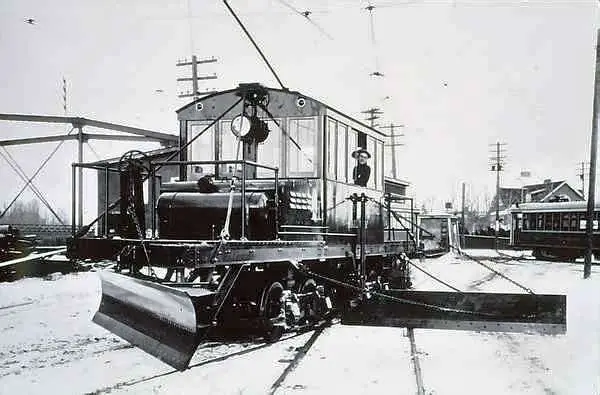 |
Officially, this unit was designated as H but unofficially, nicknamed
"Mary Ann". The car, built in 1928 by
Canadian Car & Foundry, Montreal for the Calgary Municipal Railway was a plough in the winter and a rotary broom in summer.. CMR Work equipment consisted of sweepers, track sprinklers, flat work motors such as G (equipped with snowplows in winter) and a repair car for derailed units. There were no tower cars and tower trucks were used instead. Glenbow Archives NA-2891-21
|
| Submitted by Massey F. Jones | |
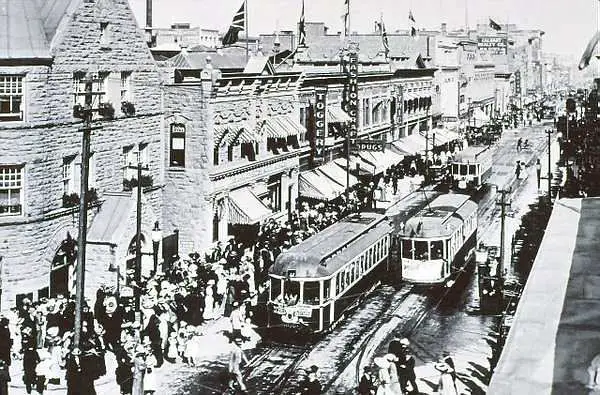 |
Calgary held the Victory Stampede, in honour of
soldiers returning from World War 1 and this was probably the occasion, on 8 Ave SE and Centre St (around the Calgary Tower today), as crowds gather along the sidewalks before or after the Stampede Parade on August 25 1919. The first Stampede was held in 1912, but the second didn't happen until 1919. The Armistice had been signed in 1918 but the only returned to Canada in 1919. 8 Avenue today is a busy pedestrian mall, with cars and trucks restricted
to deliveries and only during specific
Glenbow Archives NA-644-11
|
| Submitted by Massey F. Jones | |
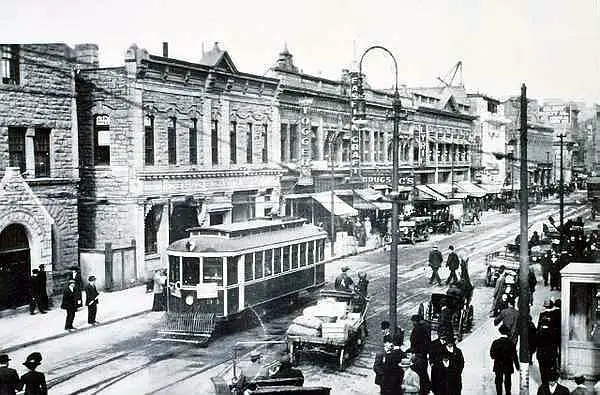 |
Calgary Municipal Railway No. 34 westbound, in
front of the Clarence Block at 120-8Ave SW around 1920. The building was owned by Senator James Lougheed and named for one of his sons. At one time, it held law offices for Lougheed and his partner RB Bennett, later a Canadian Prime Minister , Max Aitken (Lord Beaverbrook) and John Brownlee, later Premier of Alberta. The 32-foot streetcar car was built by The Preston Car Company of
Preston, Ontario and it seated 36
Glenbow Archives NA-4391-3
|
| Submitted by Massey F. Jones | |
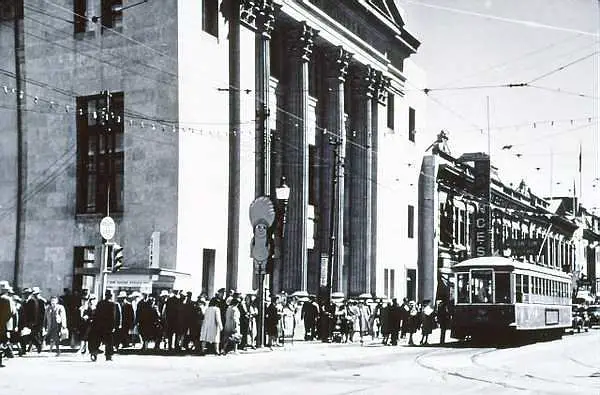 |
Streetcar 80, acquired from Springfield Mass.,
around 1919, is westbound in front of the Bank of Montreal on 8 Ave & 1 St SW in this 1920-era view. The bank had been here since 1886. The car sits 48 passengers. All-steel streetcar 80 is a PAYE (Pay As You Enter) 1-man car with a farebox, and the option of either exiting from a large air-activated folding door in front and a much smaller version of one at the rear, both activated by the motorman. At the rear door, passengers stepped on a large treadle which activated an outside folding step for alighting from the car. The photo is probably taken around Calgary Stampede time, as evidenced by the large Indian display on a post. Glenbow Archives NA-1241-968
|
| Submitted by Massey F. Jones | |
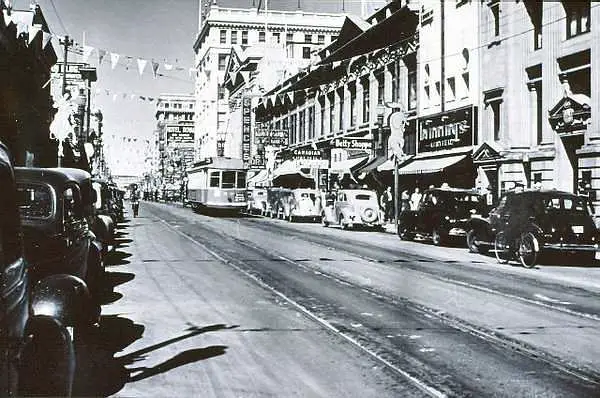 |
Westbound on 8 Ave x 1 St SW, Car 59 is about to
reach the Hudson's Bay Store, which is the large white building to the right and still around today. The streetcar could accommodate 52 seated passengers. While 8 Ave was considered "Main Street" at the
Glenbow Archives NA-1241-967
|
| Submitted by Massey F. Jones | |
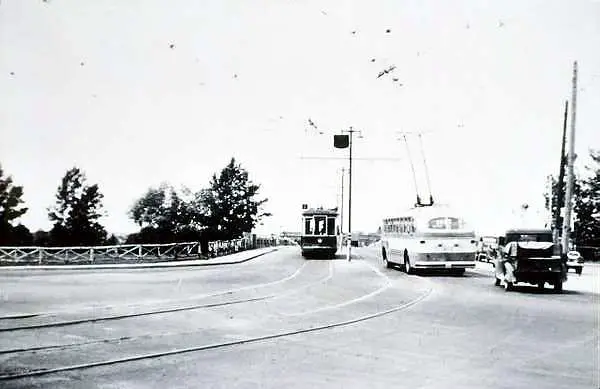 |
A few months near the end of electric streetcar service,
one of the or 80-90 steel streetcars meets its replacement on the Louise Bridge (10 St NW) in the early-50s. The view looks north from about today's 4 Ave x 10 St in downtown Calgary. In 1947, CMR, now called Calgary Transit System
Glenbow Archives NA-4260-1
|
| Submitted by Massey F. Jones |
|
|
 |
Calgary Municipal No. 84 is one of the modern
streetcars built by the Canadian Car & Foundry in Montreal in 1928. It was acquired along with 85 and 86. The car is 46'0" long, weighs 30,000 lbs. and seats 52 passengers. Six more (87-92) were purchased the following year and all lasted to the end of streetcar service in 1950. |
| Submitted by Massey F. Jones | |
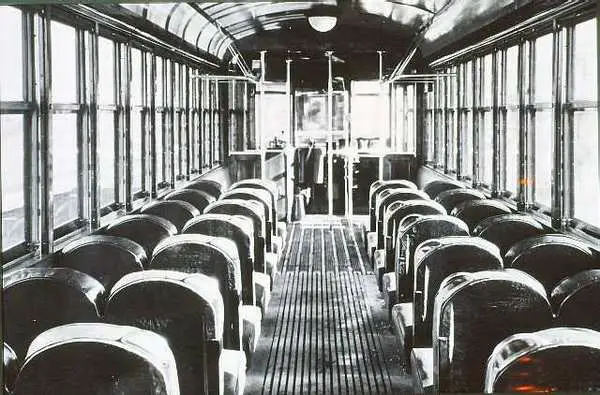 |
Calgary Municipal Railway No. 84, looking forward.
It is the Canadian Car & Foundry model 2054, a 1-man car, with front entrance and exit at the front and treadle exit at the rear through the smoking section. Notice the nice padded seats and windows that could be opened individually. The floor was wood slats, designed to capture mud and slush and be easily cleaned by hosing. To the front is the controller, shown in another picture. Each side window could be opened individually, using a ratcheting
system, where the customer pressed on two
Glenbow Archives 2891-16 |
| Submitted by Massey F. Jones | |
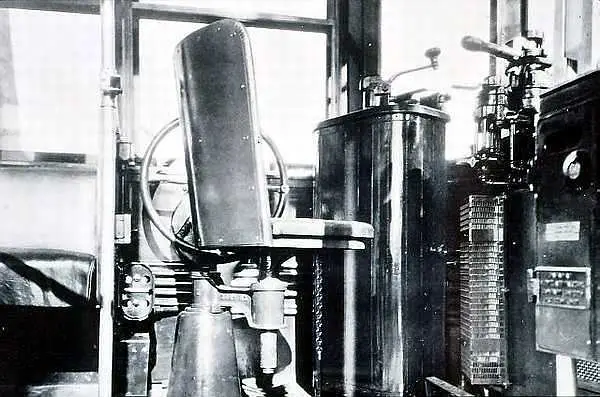 |
The motorman position, at the front of Calgary
Municipal Railway car No. 84. The view looks from the ground directly into the streetcar, as passengers would see it on boarding after the doors opened. Passengers entered by the front and placed either
Above the heater is the air brake, actuated by cylinders under the
car. Next to it, the large black column is the controller, most of which
were manufactured by Westinghouse, a large rheostat to control the juice
to
Glenbow Archives 2891-14 |
| Submitted by Massey F. Jones | |
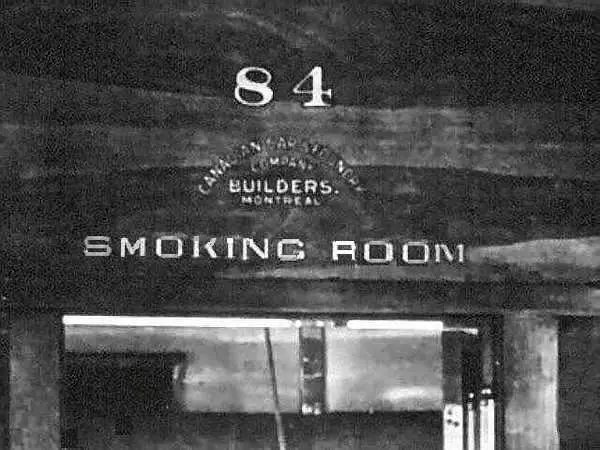 |
Smoking was still permitted on Calgary streetcars when
this photo was taken and a vestibule with a door was provided at the back of the car for those who wished to do so during the trip. Barely visible above the door below the number is the notation that the car was built by the Canadian Car & Foundry in Montreal. |
| Submitted by Massey F. Jones | |
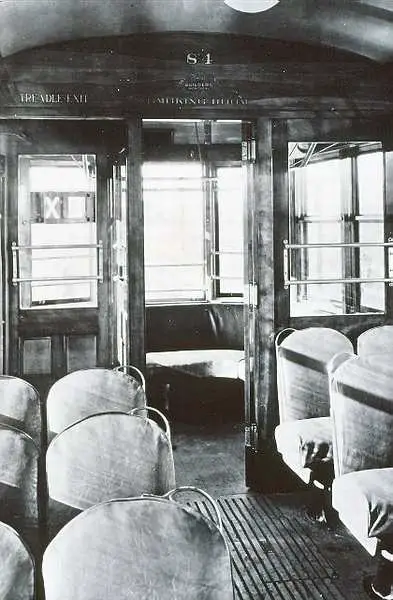 |
The bars inside are by the smoking room are for safety purposes
but those at the rear of the smoking room were designed so that pranksters
would not open the rear
window and pull the trolley pole cord. Only the centre window could be opened totally. It was a totally pul - out window, not the same type as the lateral ones on ratchet, which could be opened to a number of positions from an inch to full-open. During inclement weather, some motormen pulled out the window to reset the trolley pole and in some cities, it was an offence to open the rear window. The X is the rear roll sign, inside a box lighted from
To exit at the next stop, passengers pressed on a small buzzer between
each window, which signaled the
Glenbow Archives 2891-15 |
| Submitted by Massey F. Jones | |
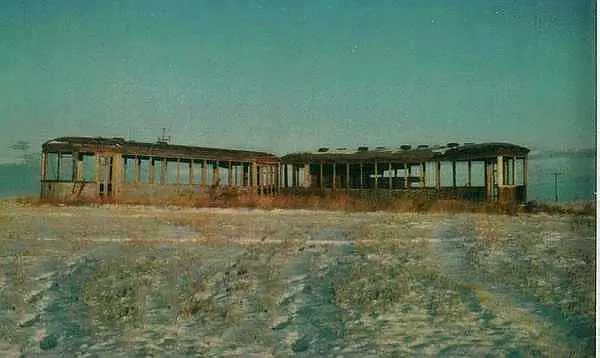 |
Jim Booth took this series of pictures of two
Regina Streetcar while in the military south of Moose Jaw Sask. The Regina streetcars were literally in the pasture near the farm house. The farm itself was located south of Moose Jaw. The farmer was quite friendly, & happy that they asked if we could photograph the cars. He can't remember how cold it was, but he had my full artic clothing on. Regina Streetcar #40 and #49
|
| This picture was taken and submitted by Jim Booth, Taber Alberta | |
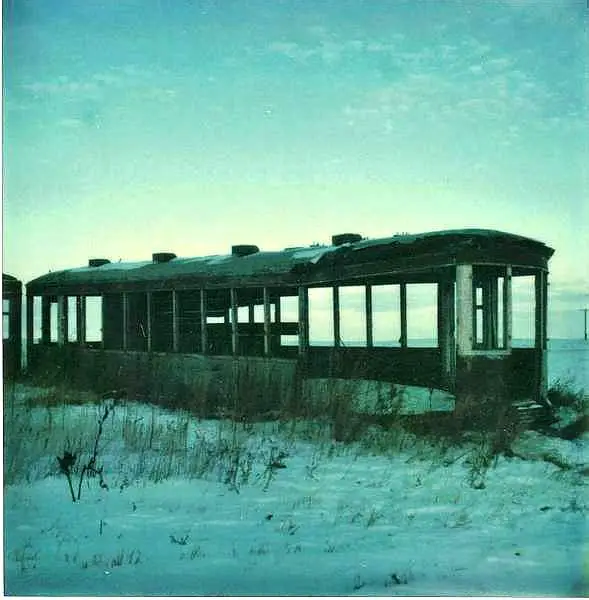 |
Regina Street cars #40 |
| This picture was taken and submitted by Jim Booth, Taber Alberta | |
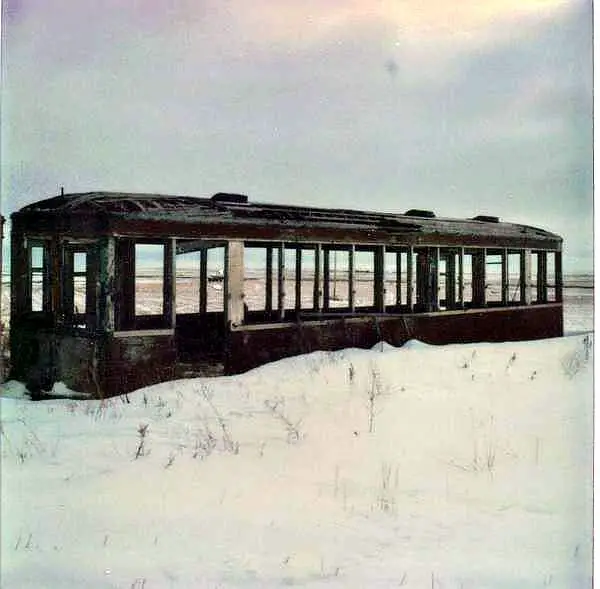 |
Regina Street cars #49 |
| This picture was taken and submitted by Jim Booth, Taber Alberta |
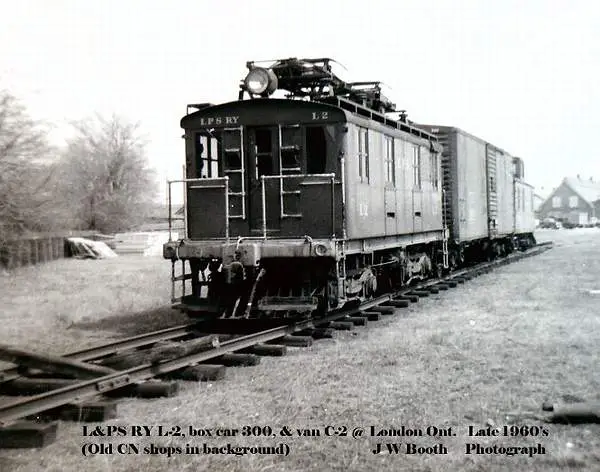 |
L&PS RY #L2 near the CN roundhouse
at
London, Ont, late 1960's |
| This picture was taken and submitted by Jim Booth, Willingdon AB | |
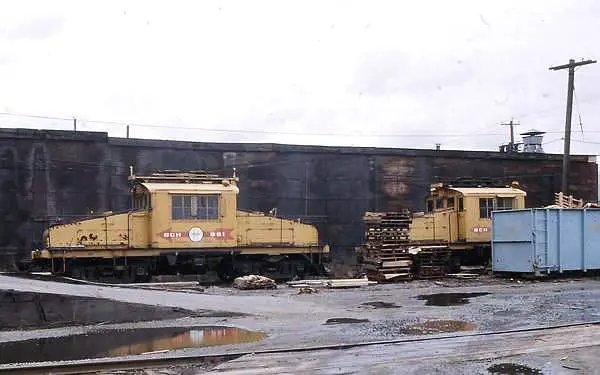 |
Among the diesel power for BC Hydro, were
steeple
cab electric freight locomotives BCER 961 and 962, two of the three GE/ALCO electrics, acquired from the Oregon Electric Railway in 1946; formerly OER #21, 22 and 23. Built in 1912 they were renumbered respectively BCER 961, 960 and 962 and operated for a long time switching freight in the Vancouver area. Electric operation on the line ceased in 1981. BCER 962 was scrapped back in 1959, while the 960 was restored by the West Coast Railway Association and is located at their Museum in Squamish, BC. The #961 meanwhile was sold to Edmonton Transit who renumbered it to ETS 2001, a picture of which is on this page. This view was taken at the BCH Carrall Street
yard (formerly at the west
|
| This picture was taken and submitted by Massey F. Jones | |
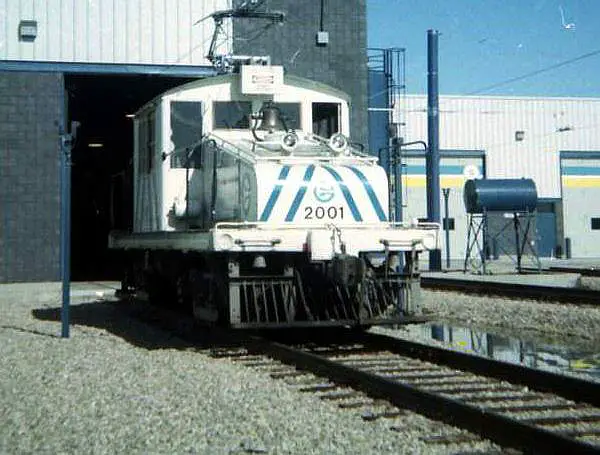 |
Edmonton Transit steeple cab electric locomotive 2001
was purchased from BC Hydro (formerly their 961) to haul out debris while building the initial LRT sysyem under Jasper Street around 1974. The 2001 was built by Alco-General Electric in June
This view is taken at the old ETS Cromdale Garage
|
| Photo Lorne Unwin - Massey F. Jones collection | |
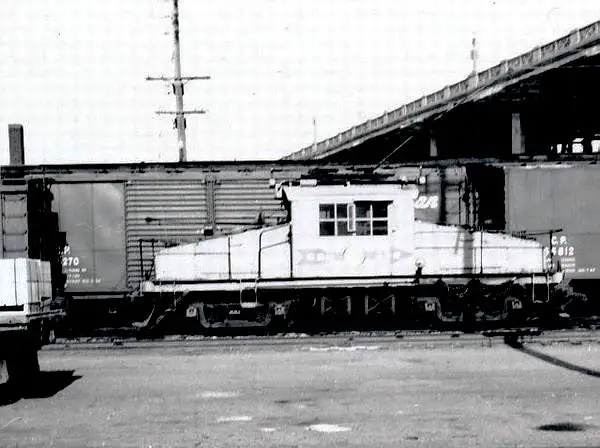 |
BC Electric 960 in East Vancouver, likely at the Carrall Street
Yard, around late-1960s mid-1970s.
Like the BCE 961 and 962, locomotive 960 is all-steel, measures 37'
7", weighs 125,400 lbs and is powered by
The 960 is now at the West Coast Railway Heritage
|
| Massey F. Jones collection | |
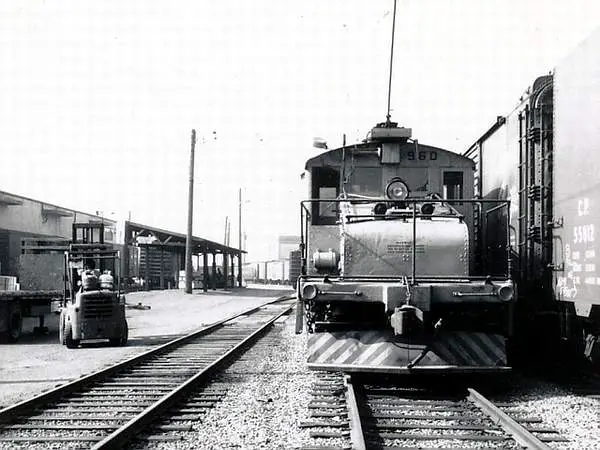 |
The rear of BCE 960 locomotive at an unknown
location. Over the years, BCER had 27 electric locomotives on its roster and hauled 448,750 tons of freight. It interchanged with CNR, CPR, Great Northern, Milwaukee Road and Northern Pacific. View a photo of the 960 in operation in 1970 at http://www.trainweb.org/oldtimetrains/photos/
The 961 featured in another photo is at http://www.rrpicturearchives.net/show
|
| Massey F. Jones collection | |
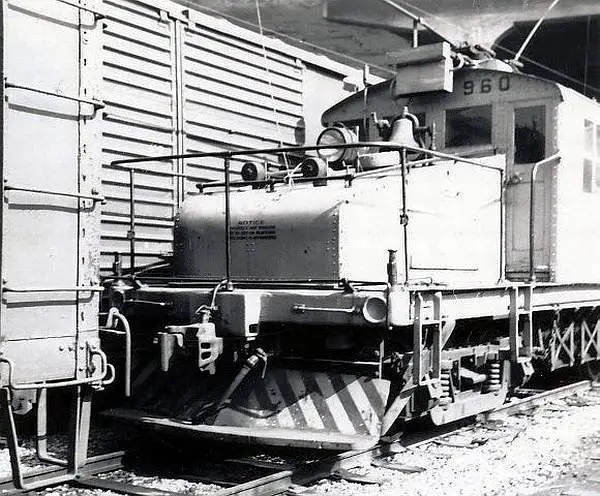 |
Those depressions on the frame are "polling pockets"
which are used to push a piece of rolling stock, with the locomotive on one track and the piece of rolling stock on an adjacent track; by using a large heavy bar made from hardwood or steel about 8' long and 6" in diameter at the centre. One trainman would then hold the bar in the locomotive pocket, while another trainman would place his end on the car to be pushed (which also had poling pockets). The engineer would then advance the locomotive very slowly and it would push the car gently to the desired location. It's a practice that was not often used but it avoided switching and coupling. |
| Massey F. Jones collection | |
 |
CNR Electric #14 at St. Catharines Ont. Sept 1955 |
| This picture was taken and submitted by Jim Parker | |
 |
CNR Electric #15 at St. Catharines Ont. Sept 1955 |
| This picture was taken and submitted by Jim Parker | |
 |
CNR Electric #21 at St. Catharines Ont. August 1956 |
| This picture was taken and submitted by Jim Parker | |
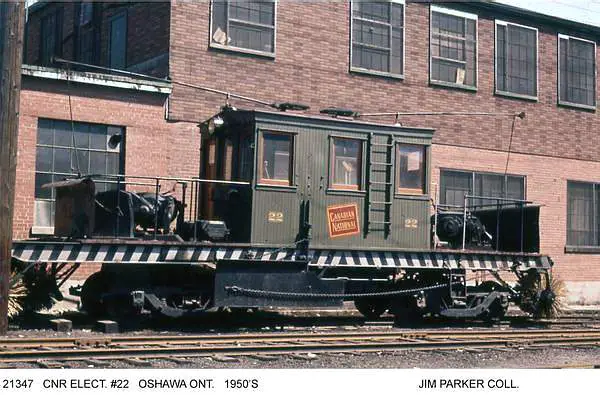 |
CNR Electric Sweeper #22 at Oshawa Ont. 1950's
Sweeper 22 was built in the NS&T shops in 1920 |
| This picture was submitted by Jim Parker and is part of the "Jim Parker Collection" | |
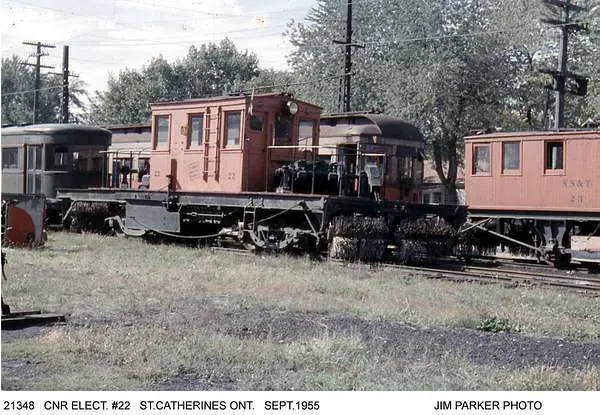 |
CNR Electric #22 at St. Catharines Ont. Sept 1955 |
| This picture was taken and submitted by Jim Parker | |
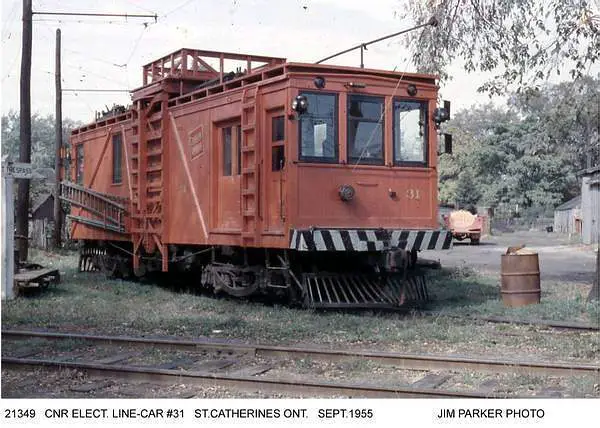 |
CNR Electric Line-Car #31 at St. Catharines
Ont. Sept
1955. This car was used to repair the overhead catenary on the electric railway railway. |
| This picture was taken and submitted by Jim Parker | |
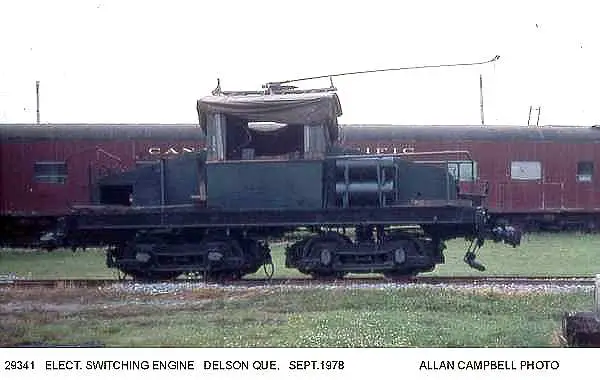 |
Electric Switching Engine at Delson Que. Sept 1978 |
| This picture was taken by Allan Campbell and submitted by Jim Parker | |
 |
CNR
Electric #15707, April 15, 1966 at the CNR
MacMillian Yard in Toronto, Ontario. CNR 15707 was retired June 5, 1968 and scrapped in Montreal, Quebec This car was used to repair the overhead catenary on the electric railway railway. |
| This picture was submitted by Jim Parker and is part of the "Jim Parker Collection" | |
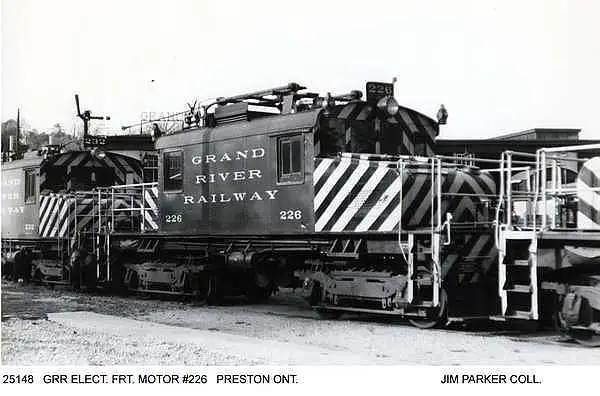 |
GRR Electric Front Motor #226 at Preston Ont. |
| This picture was submitted by Jim Parker and is part of the "Jim Parker Collection" |
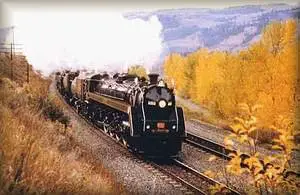 |
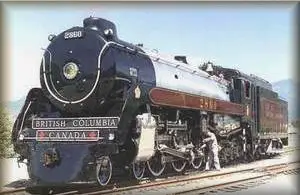 |
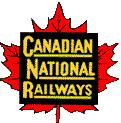 |
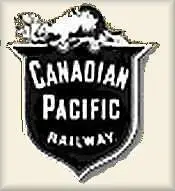 |
|
|
|
Two site worth looking at.
The
Memory Lane Railway Museum in Middleton, Nova Scotia.
The
only exclusive Dominion Atlantic Railway museum in the world
Welcome
to the DAR DPI
A web
community initiative intent on digitally preserving
the history
of the Dominion Atlantic Railway
| Privacy Policy for http://yourrailwaypictures.com/
If you require any more information or have any questions about our privacy policy, please feel free to contact us by email at [email protected] At http://yourrailwaypictures.com/, the privacy of our visitors is of extreme importance to us. This privacy policy document outlines the types of personal information is received and collected by http://yourrailwaypictures.com/ and how it is used. Log Files
Cookies and Web Beacons
DoubleClick DART Cookie
Some of our advertising partners may use cookies and web beacons on
our site. Our advertising partners include ....
These third-party ad servers or ad networks use technology to the advertisements and links that appear on http://yourrailwaypictures.com/ send directly to your browsers. They automatically receive your IP address when this occurs. Other technologies ( such as cookies, JavaScript, or Web Beacons ) may also be used by the third-party ad networks to measure the effectiveness of their advertisements and / or to personalize the advertising content that you see. http://yourrailwaypictures.com/ has no access to or control over these cookies that are used by third-party advertisers. You should consult the respective privacy policies of these third-party ad servers for more detailed information on their practices as well as for instructions about how to opt-out of certain practices. http://yourrailwaypictures.com/'s privacy policy does not apply to, and we cannot control the activities of, such other advertisers or web sites. If you wish to disable cookies, you may do so through your individual browser options. More detailed information about cookie management with specific web browsers can be found at the browsers' respective websites. |